Odd, I can see them my phone. Maybe the Discord channel?
[MOD] Imperator Invictus
- Thread starter Snowlet
- Start date
-
We have updated our Community Code of Conduct. Please read through the new rules for the forum that are an integral part of Paradox Interactive’s User Agreement.
You are using an out of date browser. It may not display this or other websites correctly.
You should upgrade or use an alternative browser.
You should upgrade or use an alternative browser.
Threadmarks
View all 98 threadmarks
Reader mode
Reader mode
Recent threadmarks
DD87: 1.9 Thales Update + Presenting Bosporan Kingdom, Armenian, Phoenician and ionian trees and lots more DD88: 1.9.1 - Sophia update, a major AI upgrade and XP tweaks DD89: AI rework part 2, the Man-eating Androphagians and the Ides of March 1.9.2 update out now DD90: Nartic faith, Blemmian, Legian and Zygian mission trees DD91: 2 Large Macrobian trees and Remastered Event Art DD92: Remastered/new art, Arvernian and Salluvian missions and Germanic tree revamps DD93: Germanic tree revamps and Middle-Eastern and Mithridatic map changes New DD94: 1.10 'Arsaces' update out now, Parthia DD and more! NewYou can see the images of the dev diarie 4 in the seven page of this thread?
It is to confirm.
Thanks
It is to confirm.
Thanks
Oh I read your post wrong, no i cant.You can see the images of the dev diarie 4 in the seven page of this thread?
It is to confirm.
Thanks
Dev Diary 94: 1.10 'Arsaces' update out now, Parthia DD, AI changes and more!
Salvete!
Today we'll be talking about tons of new content and missions for Parthia and its many variations including the Dahae and Indo-Parthia.
We'll also be further presenting more AI changes by Anbeeld and some smaller changes made to the Casus Belli's.
But first, the 1.10 'Arsaces' update is out now, you can download from here:
Steam: https://steamcommunity.com/sharedfiles/filedetails/?id=2532715348
Nexusmods: https://www.nexusmods.com/imperatorrome/mods/1?tab=files
To continue old saves, unsubscribe and remove the mod. Then download the 1.9.2 version from Nexusmods: https://www.nexusmods.com/imperatorrome/mods/1?tab=files. Nexusmods does not automatically update so make sure to remove this version and resubscribe once you have finished your old save.
Now onto the patch notes!
V1.10 - Arsaces (breaks saves, use Nexusmods 1.9.2 version to continue old saves)
New/expanded mission trees:
- Added new large mission tree and mechanics for Parthia
- Reworked/Revamped every Germanic tree
- Added new mission trees for the Horn of Africa countries
- Added new missions for the Dahae tribes, the satrap of Parthia and Indo-Parthia
- Added new missions in the Caucasus for Legia, Zygia
- Added new mission tree for the Androphagian Man-Eaters
- Added new missions for Arvernia and Salluvia
- Added new mission tree for Blemmia
- Added new mission tree for Caria
Map changes:
- Reworked the map setup in several regions including Anatolia, Cyrenaica, Greece, Iberia and Italy
- Added new Nartic faith around the Caucasus
- Added new Blemmye culture
Added content:
- Entirely reworked the Parthian invasion
- Added new content surrounding the Mithridatic kingdom
- Added new Attica, Bastetania, Hindustan, Lesser Media, Macrobian League, Pannonia and Upper Cilicia formable
- Added Temple States as a new subject type
- Added Ability to Go Raiding as a Character Interaction
- Added several new flags to Germania and various other regions
- Reworked Levy Templates of minor cultures in Anatolia
- Added historical character/family names to various cultures
- Added new deities to various religions
- Added lots of new event pictures and implemented them into existing events
- Added/rebalanced a dozen heritages
- Added several new cultural inventions for the Caucasus cultures
- Added ability to build Pirate havens for Pirate countries
Changes:
- Touched up Armenia's mission tree with standardized culture points mechanic
- Adjusted various missions to the new map setup
- Rebalanced Albion's tree
- Nerfed conquest CB to give parity to attacker and defender
- Reworked the land and naval wargoals to be more useful
- Updated German translation
- Added new partially complete Russian translation by Zavarin19
- Reworked the countries with missions GUI
AI Changes:
- Added experimental "AI Recruiting More Mercenaries" game rule that makes wars against AI countries significantly more challenging
- Disabled AI migrations temporarily due to 2.0.5 vanilla bug where migration armies get swiftly deleted by the AI, removing the country from existence
- Reworked how governors choose their policies, making their decisions more optimal, but also with more influence from governor traits
- AI countries can now use Harsh Taxation if their research efficiency is above the cap
- AI will now heavily prioritize building farming settlements in states with a lot of cities, saving them from running out of food
- AI now takes current and maximum research efficiency into account when choosing buildings and inventions. Once a country reaches high enough research efficiency, it will prefer buildings that promote Freemen and Slaves instead of Nobles and Citizens, leading to higher tax income and more manpower
- Improved AI priorities regarding aqueducts and metropolises, leading to higher amount of them in AI countries in later stages of the game
- Reenabled inventions for transforming into dictatorship for AI countries. Great powers (think Rome) have quite a decent chance to take them, while for major powers it's much lower, albeit non-zero
- AI can now use Lax Tributes economy policy to improve relations with subjects they couldn't otherwise integrate
- Improved AI decision making regarding Increased Army Maintenance and Increased Wages economic policies
- AI countries now actively use Unit Reorganization ability on low morale mercenaries to reduce the time it takes for them to be ready for battles
- Disabled Municipal Self Rule and Grant Clan Autonomy for AI so they don't lose territories
- Lowered early game Armenia aggression
- Slightly lowered the aggression some traits give
- Civil wars no longer trigger if under 5 territories to prevent unwinnable civil wars for AI from triggering (up from 2)
Bugfixes:
- Updated files fully for 2.0.5
- Fixed Fortify Province investment not giving +1 fort limit due to vanilla bug in 2.0.5
- Fixed a number of broken mission requirements
- Fixed training characters potentially instantly cancelling
- Fixed macrobuilder showing too many tabs for several buildings
- Fixed many cases of bad indentation
- Fixed several poor triggers and effects on vanilla missions
- Fixed lots of edge-cases and bugs on existing missions
- Replaced is_port = yes checks with num_of_port_building >= 1
- Cleaned up old, outdated and disabled content
- Fixed a ton of spelling mistakes, loc errors and bad grammar
For the Dev Diary and the Parthian content, i'll start by handing you off to Peterson.
Hi all, Peterson here with stuff I hope will be interesting.
As many of you, I was always a bit taken aback by lack of Parthia-related content - Invictus adds a lot of extensive and cool stuff throughout the map (Albion, Cyrenaica, Bithynia for starters I think are gold-standard), but whatever content there was for Parthia was, by comparison, well, lackluster. As such, after three years of playing this game, I decided to do something about it.
Saying I did is a bit misleading - many, many thanks to absolute legends Zorgoball, Duart and Izn for doing the beautifully written localization, Chehrezade and Siya for content ideas and research, Zamensis for letting me steal bits and pieces of his code. Nevertheless, if I counted the hours I spent doing all of the stuff that I'm about to show off, frankly I’d probably be appalled.
Historical context
For some quick historical perspective - the Parthian Kingdom/Empire that y’all might be familiar with came about because of a nomad invasion into Iran (not too dissimilar to the Seljuks many centuries later). The guilty party were the Dahae tribes under the leadership of Parni chieftain Arsaces. The Seleukid satrap of Parthia, Andragoras, declared independence in the 240s BCE and the Dahae were quick to take over that land. The Dahae apparently quickly adopted Parthian language and customs.
30 years later, during Antiochus III the Great’s eastern campaign, Parthia submitted again to Greek overlordship, now under its new, non-Greek, dynasty. The Arsacid dynasty proved to be tenuous subjects though, and conflicts and raids persisted, with consecutive territorial gains. True breakthrough came about during Mithridates I’s rule, in 140s BCE, with sweeping territorial gains resulting in what you roughly might think of when you think of the “Parthian Empire”.
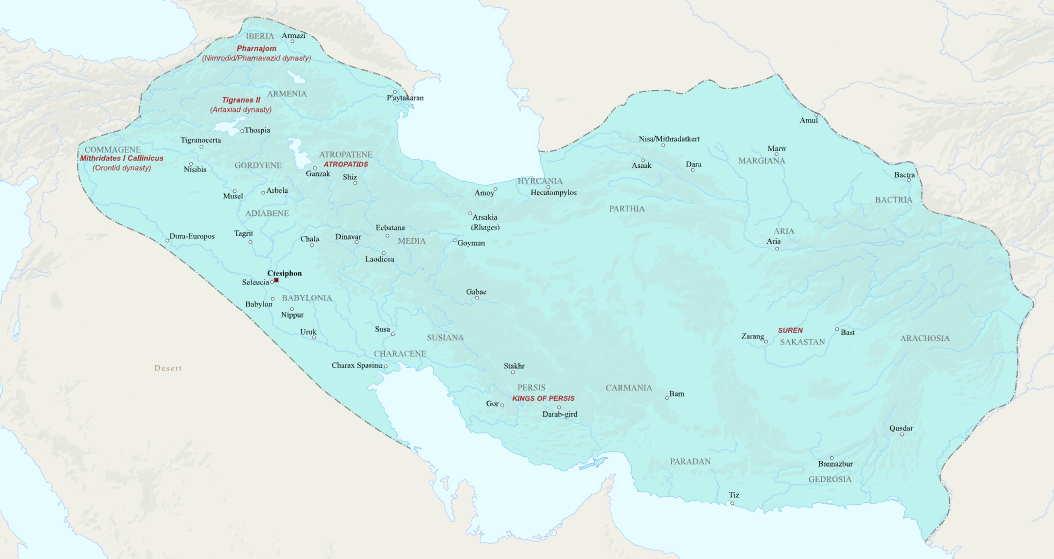
The Arsacid dynasty generally ruled with a light touch, preferring to have many subjects, and assimilation into Parthian culture was not generally the focus. As such, transforming all of this history into something Imperator:Rome can manage has led to many interesting solutions.
How it used to work
Until now, Parthia was just taken care of content-wise by an event that triggered roughly thirty years in-game, which:
Invictus added an event that triggers a bit later that allows you to convert to a chosen religion.
This is essentially all totally gone, considering that, in light of what happened historically, it was nonsensical. Now, onto the main course(s).
Dahae Belligerency Situation
When playing in Iran/Mesopotamia, roughly half a year into the game you’ll be greeted by an event that starts off a situation not too dissimilar to the EU4 Nomadic Frontier disaster. This is essentially a slider that ticks up/down depending on set circumstances.
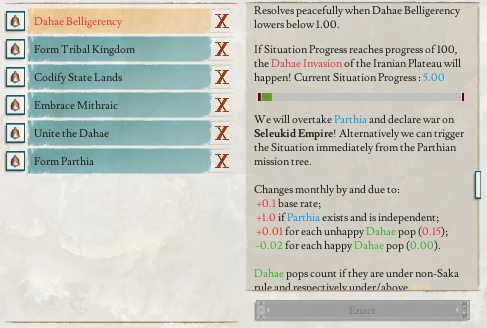
Viewable from the decisions tab (it was decided against doing a separate screen, similarly to how CK3 handles this type of content) and well, everything should be self-explanatory when seeing the screen. If the slider goes to 100, then the Dahae Invasion will happen as it would in vanilla, also roughly thirty years into the game. Essentially this design ensures couple of things:
If you resolve the situation peacefully though, all countries around Iran will sigh in relief and get some stability, including yours. This might come in handy when playing on satrapal Parthia (“Greek Parthia”), because if situation progress reaches 100 when playing as them, you’ll get tagswitched to post-nomadic Parthia (“Big Parthia” or just “Parthia”).
Greek Parthia mission tree
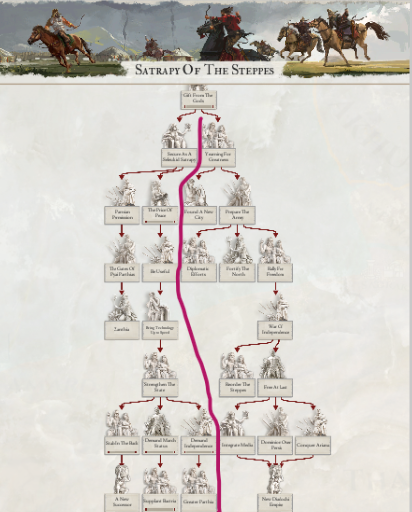
Starting on this country you’re looking at a mid-size mission tree with 2 mutually exclusive paths: let’s call them Loyal and Independent paths, correspondingly on the left and right above.
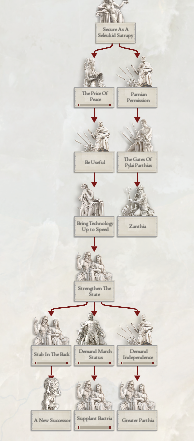
Loyal path is in all honesty reskinned Cappadocian loyal-to-Antigonids path (I know Eumenids and Cimmerians get all the spotlight on this country, but the loyal path is an amazing piece of content…like the whole tree btw).
Tasks revolve around:
Then the choice is to either: (i) really stay loyal (and become a March, a new subject type - will be described later), (ii) become a more local variant of the Greco-Parthian kingdom or (iii) take up the mantle of a new Diadochi (you’ll get a dynastic name for the country and access to Hellenistic Empire mission tree).
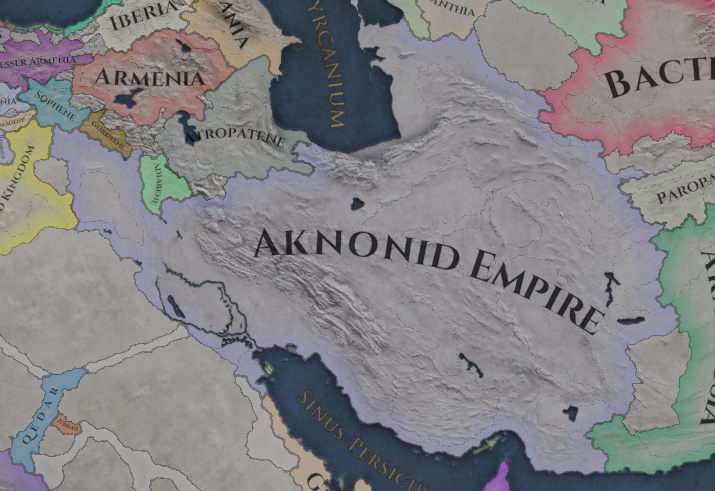
Being on the March path additionally lets you smear Bactria’s reputation in front of the Seleukids and declare war on them, to become the sole northern flank of the Greek world (Yaudheya content).
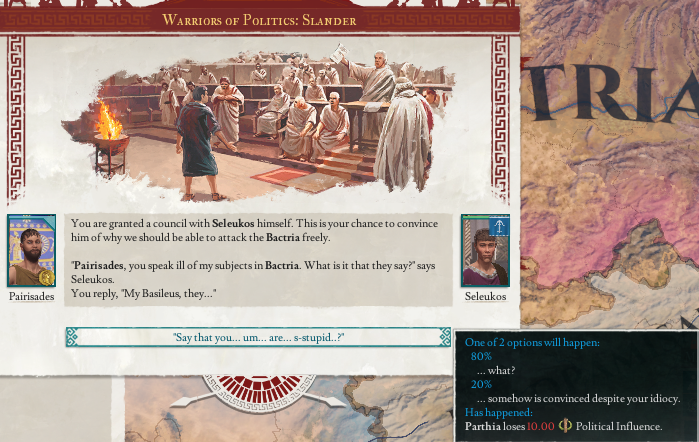
Mind you again, if you can’t resolve the Dahae Belligerency Situation peacefully, you’re gonna lose access to everything here and switch to Big Parthia mission tree.
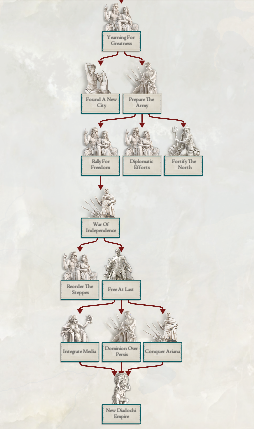
Independent path, as you might expect, is designed to quickly lead you to independence and as such get you tools for this goal.
Your levy will get transformed into a legion, which you’ll have to drill. After reaching certain readiness, you can go for the expected David vs Goliath scenario and strive for freedom (Bactria can be enticed to declare independence alongside you, but the Seleukids will be preoccupied with attacking you). The goal is to become a proper Diadochi in place of the Seleukids and continue to reform the Hellenistic Empire via its mission tree.
If you build fortresses near the Dahae tribes, you can meaningfully guard against their takeover. By which I mean you’ll get either a choice to be taken over, or choose to fight. The invasion in this scenario will be greatly weakened, so you actually do stand a chance.
Dahae Mission Tree
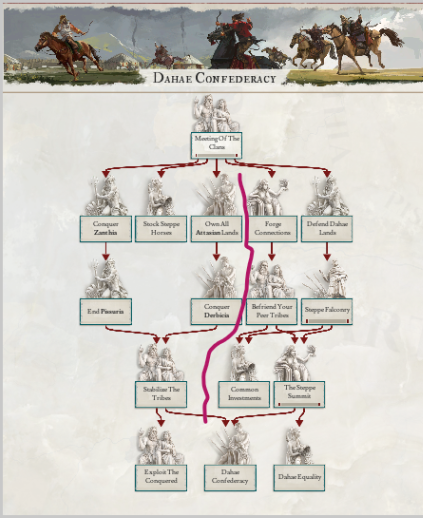
Small-ish tree with also 2 mutually exclusive paths (say “Conquest” and “Diplo” respectively). Start your game as either one of the Dahae tribes:
Attasia and Derbicia are not really Dahae, they’re Massagetae, but vanilla requires their territory to unite the Dahae tribes. I’ve decided to keep this in place so the unification process isn’t just involving two other tags, as that’d be lackluster. You can make a headcanon that they’re very close culturally to Dahae due to proximity.
How the Conquest path works and what’s behind those tasks is pretty self-explanatory I guess. Doing them gives some small local rewards and slightly boosts your Ruler’s skills with a focus on martial, and at the end you can get some manpower back to facilitate even further conquests.
The real gourmet part is the Diplo path - if you can’t be bothered to race around with your disheveled clan armies, you can unite the tribes this way. Path slightly boosts your Ruler’s diplomatic skills and stuff to do includes, among other things, e.g.:
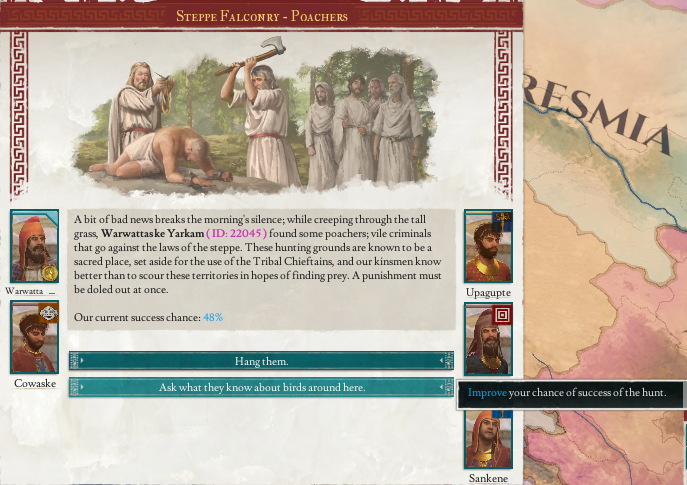
Ck3-style hunting event-chain - get other rulers to gather and go for some falconry and drinking. Networking is very important, as every third post on LinkedIn will remind you.
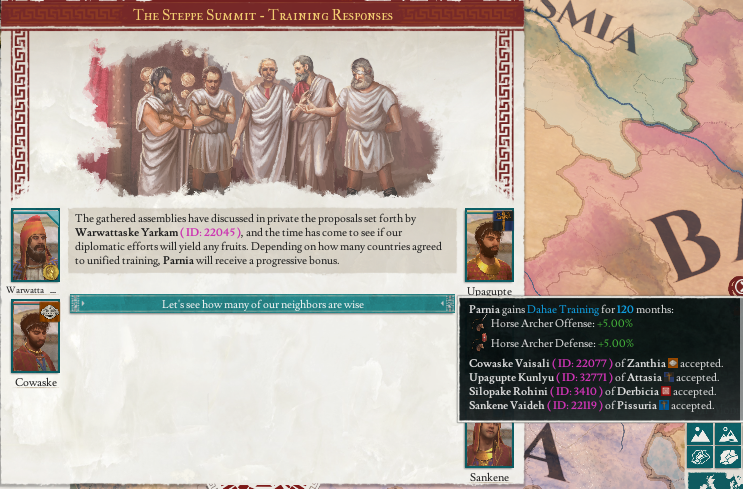
Hoi4-style imperial conference event-chain - if you did your part to try to convince other chieftains to agree for uniting the tribes into the Dahae Confederation, you can do a diplomatic summit in which, depending on the diplomatic opinion and friendships, other Chiefs will agree to unification. During the Conference you’ll also discuss some pertinent issues and, depending how many tribal leaders agree, all accepting tribes will get couple scaling bonuses.
All other tribes must agree, however, and should the Conference fail, you get claims and can always go for the obvious direct alternative.
Anyway, both paths lead down to formation of Dahae (duh) and renaming your ruling family into the Arsacid Dynasty.
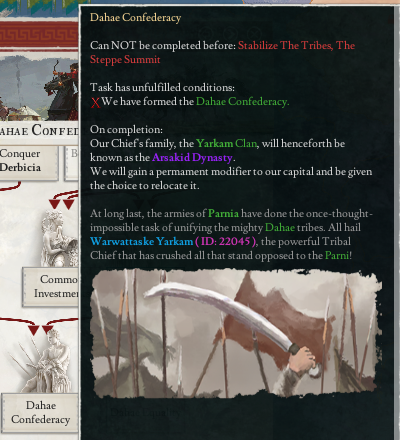
Big Parthia mission tree
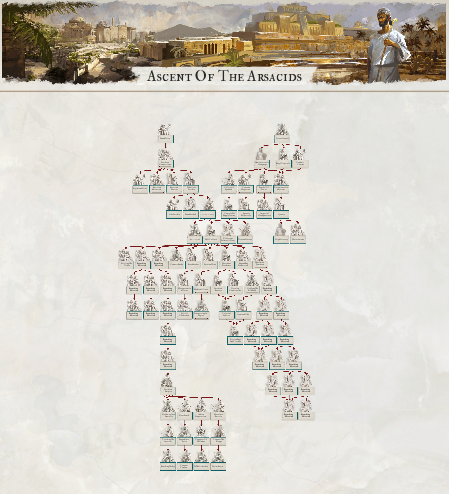
Upon the conclusion of the Dahae tree or getting switched over from Greek Parthia to Big Parthia, you access this monstrosity. Around 90 tasks, but in reality it’s 130 different ones, you’ll see later (and hopefully in a couple playthroughs!) why there’s a giant discrepancy.
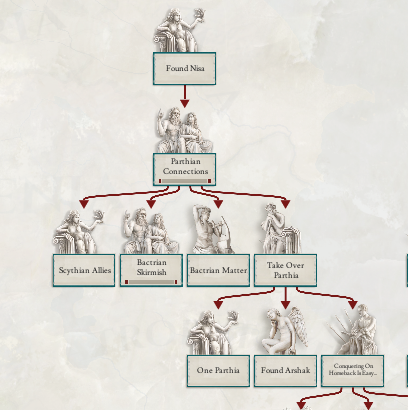
First couple of tasks mostly concern preparation for further conquests:
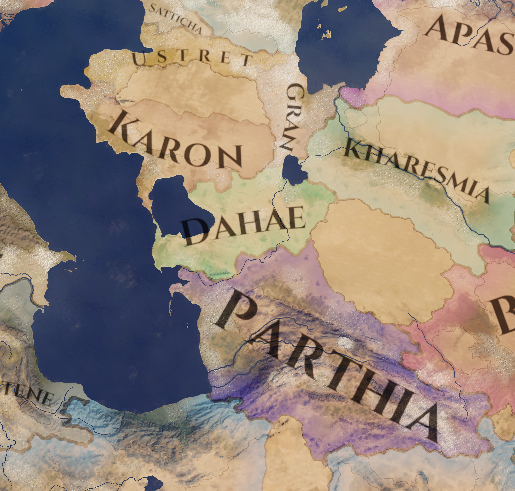
After Greek Parthia gets independent, you can swoop in and annex them. This allows you to actually form Big Parthia/Parthia, and one task resettles your pops to the region; some land gets left for a Dahae tribal vassal, and land further north gets split into area-based tribes (alternatively your Scythian ally gets them).
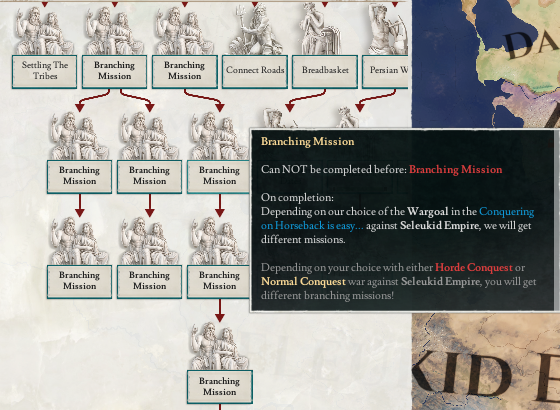
This gets you to a very important decision that’ll shape the rest of the campaign - will you wage an imperial challenge war against Seleukids or fight a normal war? Your decision correspondingly changes the Branching Missions - as shown above - into either Imperial WG missions or Conquest WG missions.
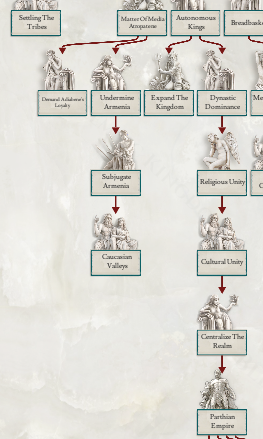
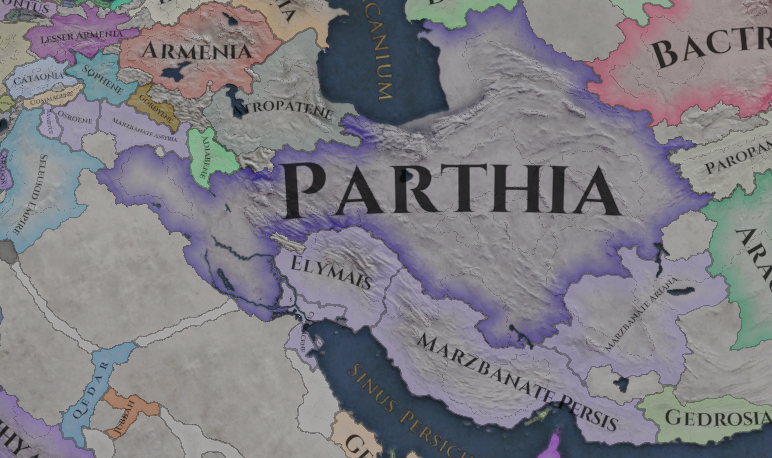
Imperial WG missions stem from the fact that using mechanics of this wargoal you’ll likely conquer most of the Seleukids in one war, so not differentiating between that playstyle and playstyle from cutting Seleukids piece-meal is just dumb. Also represents historical decentralization of the realm and balances it out with normal war option; obviously IC-wars will always be faster.
Key point here is that after the war, you’ll be able to hold only 3 regions directly (historically known as Dastgerd). You get to choose which regions, and for example choosing Mesopotamia+Media+Parthia gets you the result above (Parthia gets bulked out a bit for historical borders). Regions must border each other, but every couple of years you can switch them out if you so wish. Biggest culture in a chosen region gets automatically integrated.
What you can’t hold directly will spawn a March - new subject type, that gets you some monthly military experience and itself gets defensiveness bonus. It can declare external wars and is not diplo-annexable, differentiating it from satrapy. Those are purple things in the picture above.
Additionally during this war Osroene, Elymais and Characene might get free (later request March status so you’re not incentivized to murder them) and Seleukids might ask for peace in exchange for leaving them alive in Syria, which will net you some tools to manage your new giant landmass better and even the hand of a Seleukid bride. This is designed to be a worthwhile option to get you to historical borders on the Euphrates and not kill the Seleukids entirely.
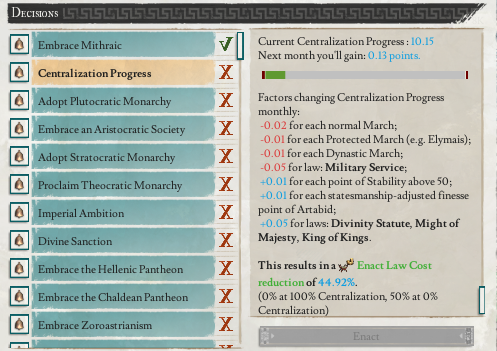
When on this branch, the goal is to get this gov ability slider (viewable in a decision tab) to a 100. That slider, which you might recognize from extensive use in EU4, gives scaling down law enactment cost, to ease the burden from reforming from your nomadic roots. Rules of up/down ticking are probably self-explanatory, but mind you, because of monthly passive military experience gained from having Marches, it might not be too wise to rush the process.
To help you with centralizing Marches, mission tree leads you down converting them to your culture and religion, also you need to appoint members of your family as their rulers. If you get the slider to 100 one thing remains to be done - fight off a big civil war, akin to Roman/Hellenistic Empire ones. After this, you function as a “normal” country, with some bonuses thrown in for your trouble and namechange to Arsacid Empire (or Parthian Empire, if you f’d up somehow keeping those guys in charge).
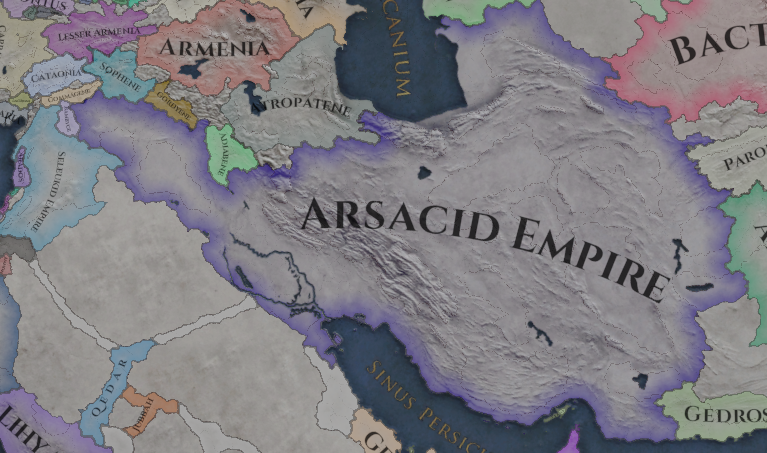
Other tasks concern bowing your neighbours into submission - you can request they become Marches. Whether or not they bow is opinion-dependent, and each gives a timed modifier based on their heritage. If they don’t submit you get claims but again, mil XP in this game doesn’t fall out of the sky so it just might be better to be diplomatic. For the Armenian subjects, Gordyene and Sophene, you’ll have Cyrenaican-style decisions to steal them from Armenia (in that case it was for Delian League, in conquest of the Aegean mission tree).
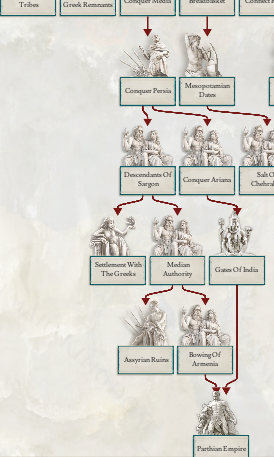
Alternative to using Horde Conquest wargoal and Imperial WG missions is always to cut Seleukids piecemeal. Missions here should be quite self-explanatory, and some tasks for requesting submission double from Imperial WG missions.These missions converge with Imperial WG missions on having formed the Arsacid Empire, albeit here without the civil war and with less bonuses.
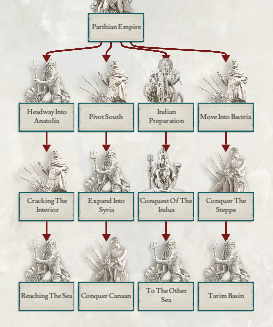
Grind never stops however - you need to surpass the Achaemenids, or at least achieve parity with their glory.
This gets us to another Branching Missions - this time for different religious paths, courtesy of Izn. Current selection includes Mithraic, Zoroastrian and Hellenic sub-trees. Selection is performed via appointing to the office of High Priest a guy of the religion you want to convert to (guys spawn from one of the preceding tasks).
Salam and hello! It’s been a while, this is Izn speaking! As Peterson mentioned, I worked on the 4 religious branches of the Parthia tree. I’ve included everyone’s favorite: religious controversy, syncretism, and conversions. Let’s start with Mithraic.
The Mithraic path has been designated as the ‘historical’ path, which is a controversial choice for sure. Regardless, I’ve tried to make sure there’s plenty of syncretism and cobelief with Mazdayasnan (Zoroastrian) belief as well. There’s a whole path of Mazdayasnan based religious flavor, and my intention is to make the player feel not like they are following a wholly different faith, but a different version of belief. The Mithra side of the tree is filled with reverence and symbolism of the Lord of Light, who the historical Parthians had a huge emphasis on (ultimately the reason we went with Mithraic as the ‘historical’ path).
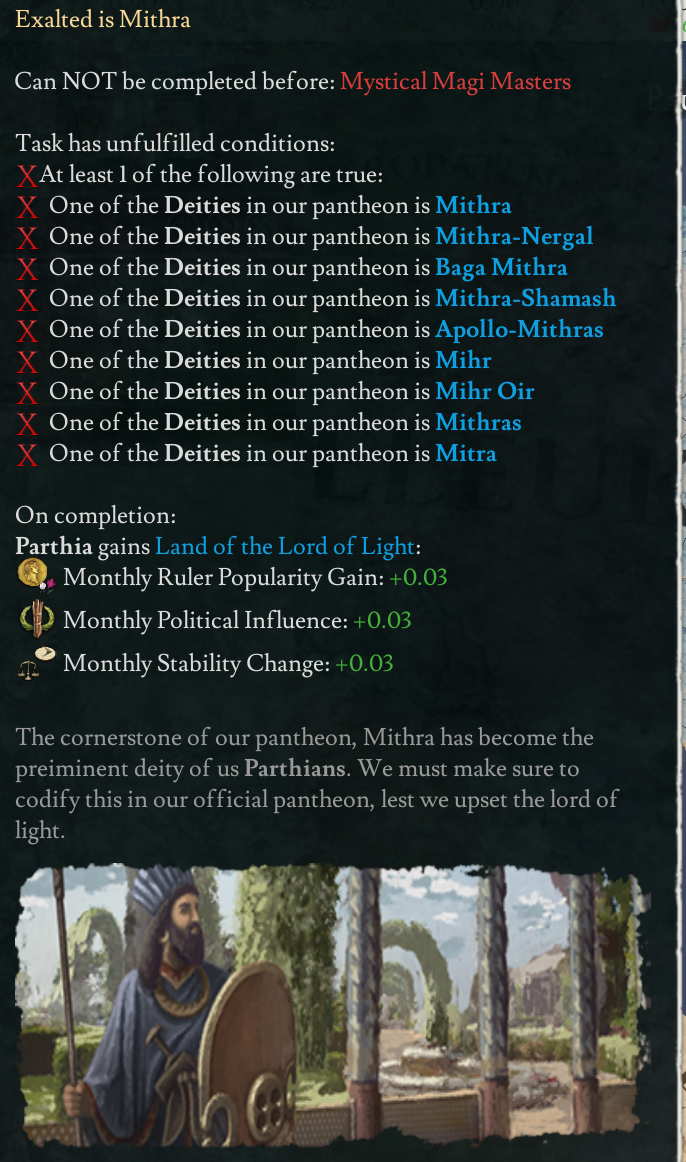
The Zoroastrian path, or rather, the Mazdayasna path emphasizes the role of Ahuramazda over Mithra. But Parthians being Parthians hardly follow an orthodox version of Mazdayan belief. They’ll still worship Mithra and keep Median influences, just with a caveat that it comes through and beneath the Wise Lord’s will.
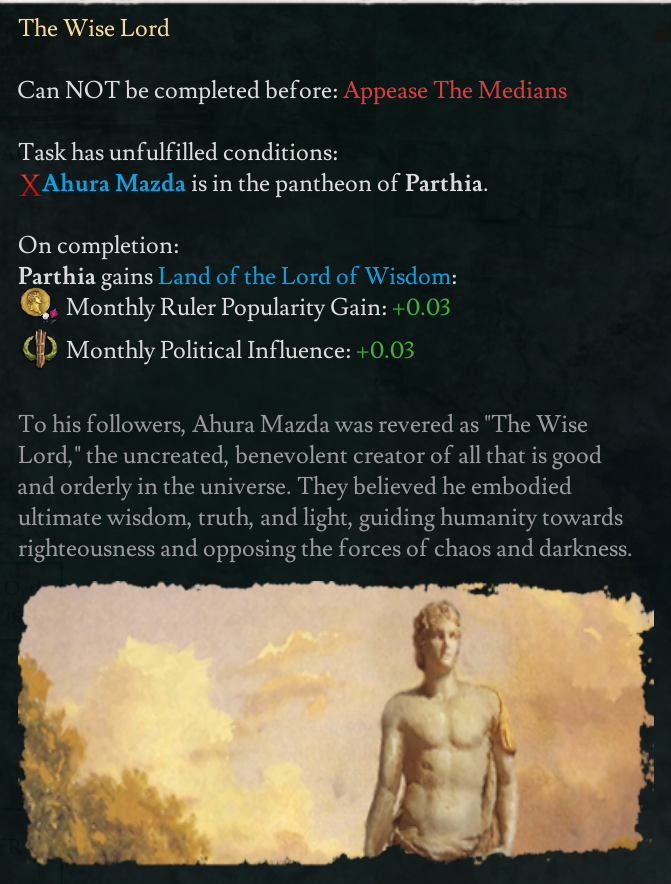
The Hellenic path is filled with syncretic deities of all different faiths. As a minority religion, the narrative describes how it becomes somewhat of a prestige religion, before ultimately becoming a strange amalgamation of Zoroastrian and Hellenic traditions. The map may not show just how syncretic the religion of the Parthians is, but hopefully through the tree and your pantheon, you’ll feel like you aren’t truly one faith or another.
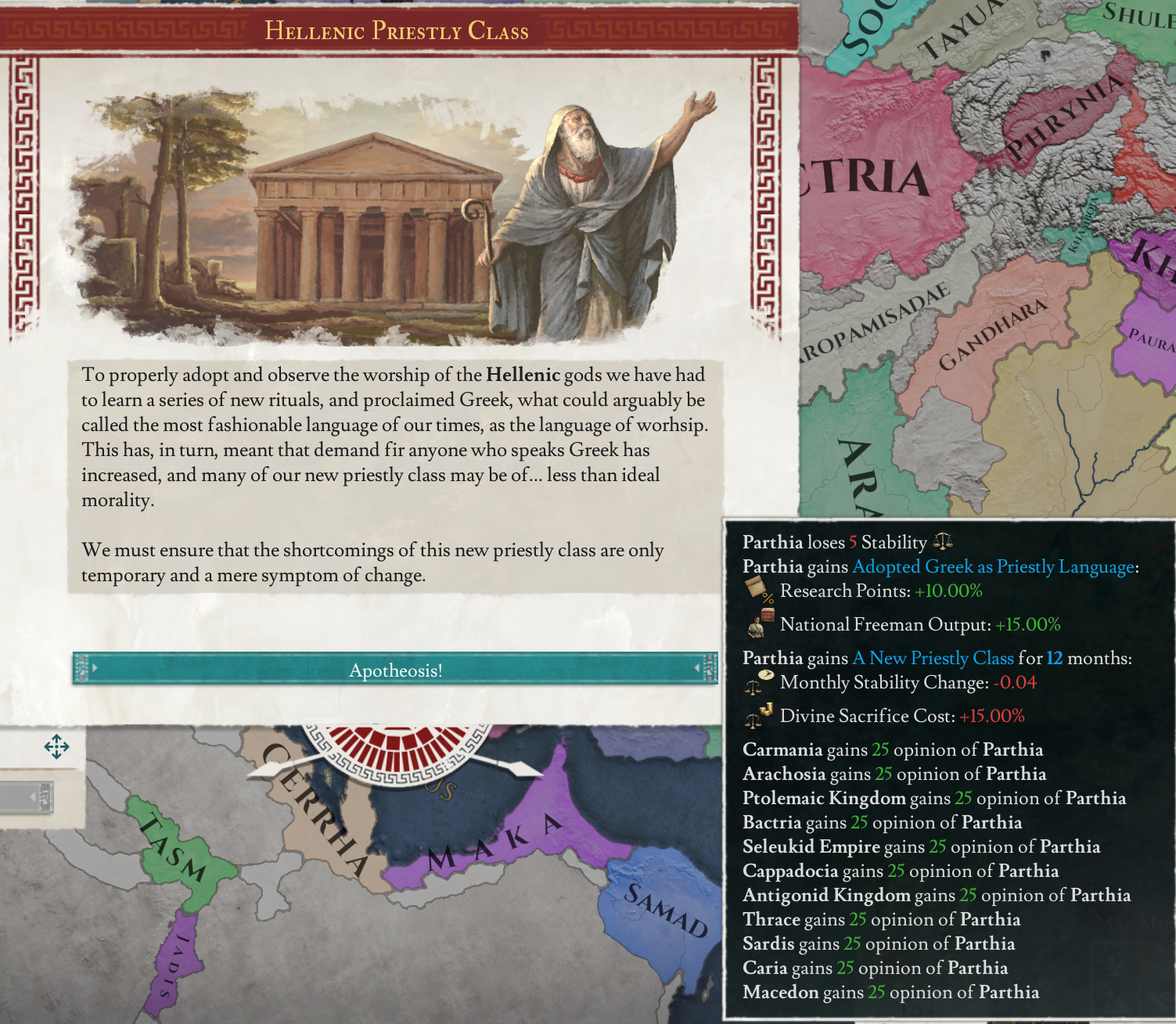
The Buddhist path was sort of a personal project, unlike the other faiths, this path is probably the least historically based. There are a few sparse claims that Buddhism had somewhat of an impact on the eastern nobles of the Parthian empire, however there’s not much to go off there. Instead, you’ll enjoy a lot of Irano-Buddhism found across Central Asia and the Indus Valley. One unique thing about this path is in order to become a sage (Apotheosis), you will need to reach Nirvana-in-Life, not an easy task, but certainly rewarding. Anyhow, back to Peterson!

Additionally, courtesy of the GOAT Shinymewtwo, Zoroastrian, Hellenic, and Buddhist paths grant you new flags (standard Parthian flag has a Mithraic symbol so it obviously clashes; leaving it intentionally as a default though since most of the Parthian pops are Mithraic so it’s still adequate).
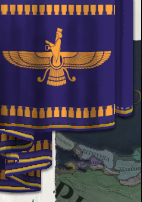
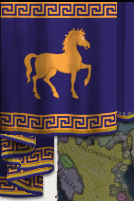
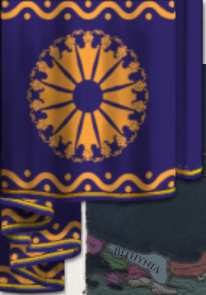
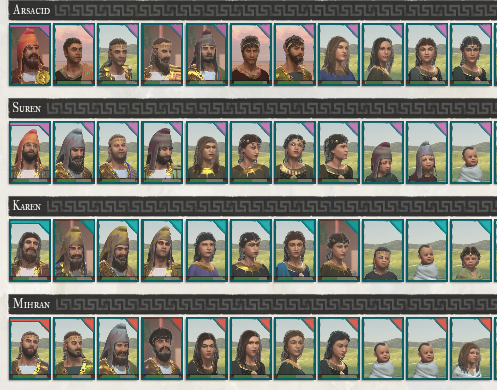
Another sub-branch concerns political developments, for example:
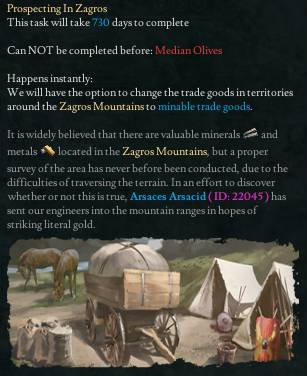
Last sub-branch concerns economic developments, which among many other things offers:
And last but definitely not least, here you have a going along the Silk Road event-chain, a la Albion travel (but linear, because well, it’s a road-based voyage, not an open seas-based one). Just like Albion's trip, you'll have 1,000 gold coins to play around with as you stop at various cities along the trade routes, with a total of around 30 events to enjoy.

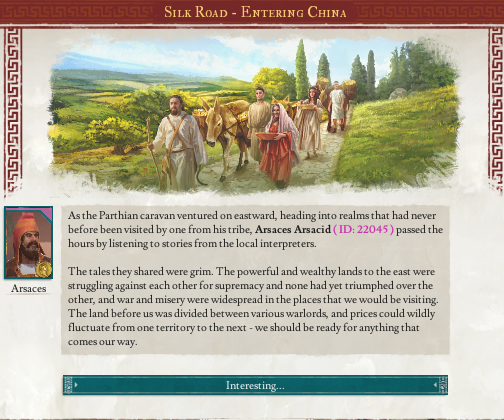
You can even follow your traders on the map a bit! Obviously not all the way to China, as the map ends where it ends.
As to what’s there content-wise, I’ll let you all find out for yourselves because even beginning to describe the amount of content there is a futile task. Let’s just say that for example you can have a Byzantine monk moment and steal some silkworms for domestic production.
Indo-Parthia mission tree
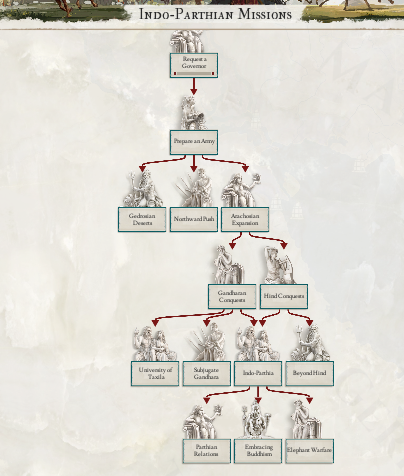
Historically Indo-Parthian kingdom was formed by the governor of the in-game Ariana region, Gondophares, likely of the house of Suren, just at the tail-end of I:R timeline. But hey, if it’s in the game, they can also get something cool.
When playing as Big Parthia, you can form Indo-Parthia in 2 ways:
Choosing to form Indo-Parthia from Big Parthia skips some things, so I’ll focus on the switched-to-subject gameplay.
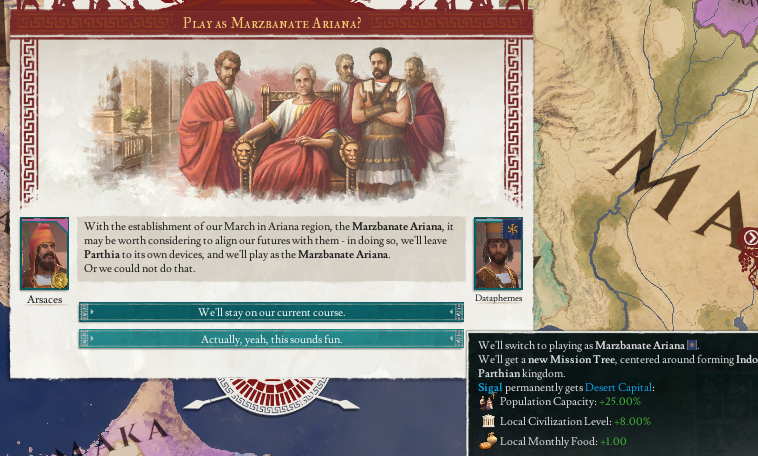
First things first you’ll need to request a governor from one of the Parthian great houses. This comes with access to more funds, as that governorship is but one of that family’s assets - for the time at least.
Then, since you’re a March subject, you can go conquering east of you. Obviously the biggest obstacle is the Mauryans, so it might just be worthwhile to wait for their collapse (or help them expedite the process). Eventually, after conquering the Indus river valley, you can click the Indo-Parthia formation decision, which also will make you independent. Be warned though - your former overlord just might request lands you possess west of the Hindu Kush mountain range (so essentially Ariana and Bactriana regions), depending on your relations.
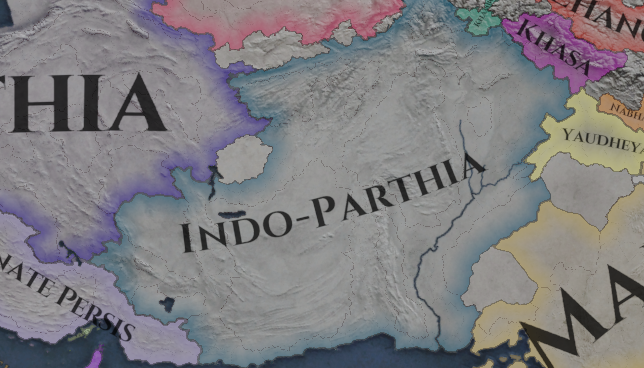
After formation, relevant for it task gives you quite unique rewards:
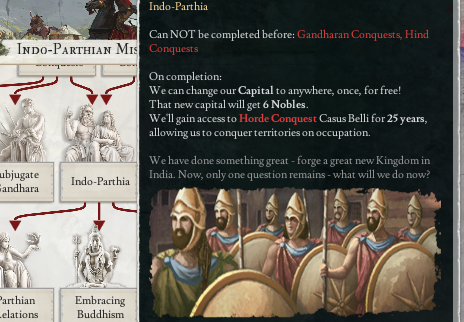
You can now go ham and become the Mughals of antiquity. I assume it’s a country 5 people will ever play, so just wanted to add some fun stuff that’s unique and not labour intensive, such as:
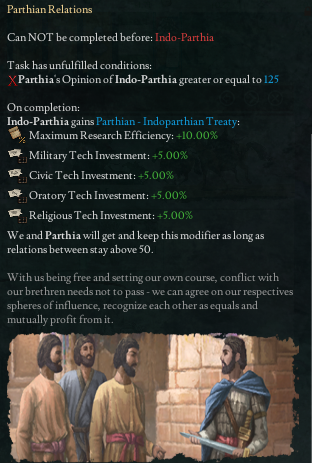
Historically Indo-Parthians got independence easily and were seen as equals by the Arsacids, and friendly relations persisted - this can be replicated, and as long as both countries hold positive opinions of each other, both can prosper.
And this concludes content additions for my own little Parthia DLC. Complaining “where the Parthia content at” is henceforth invalidated.
Map change
As some more observant of you might have noticed in some pictures, courtesy of Izn there’s one more Seleukid subject - Paropamisidae. This territory used to be directly owned by the Seleukids and was jolting unseemly over Arachosia, and now it’s a separate satrapy. The ruler of the satrapy is none other than the father of Alexander’s favorite wife, Roxana. It has ambitious content plans coming in a future update, perhaps involving some revenge for the murder of Roxana. The Seleukid starting event got tweaked accordingly, and will not significantly change the outcome of the Seleukid-Mauryan war. If Seleukos truces with Maurya, he keeps Paropamisadae under his realm, and if he wars with Maurya, he will take over Satrapical territory in order to facilitate war.
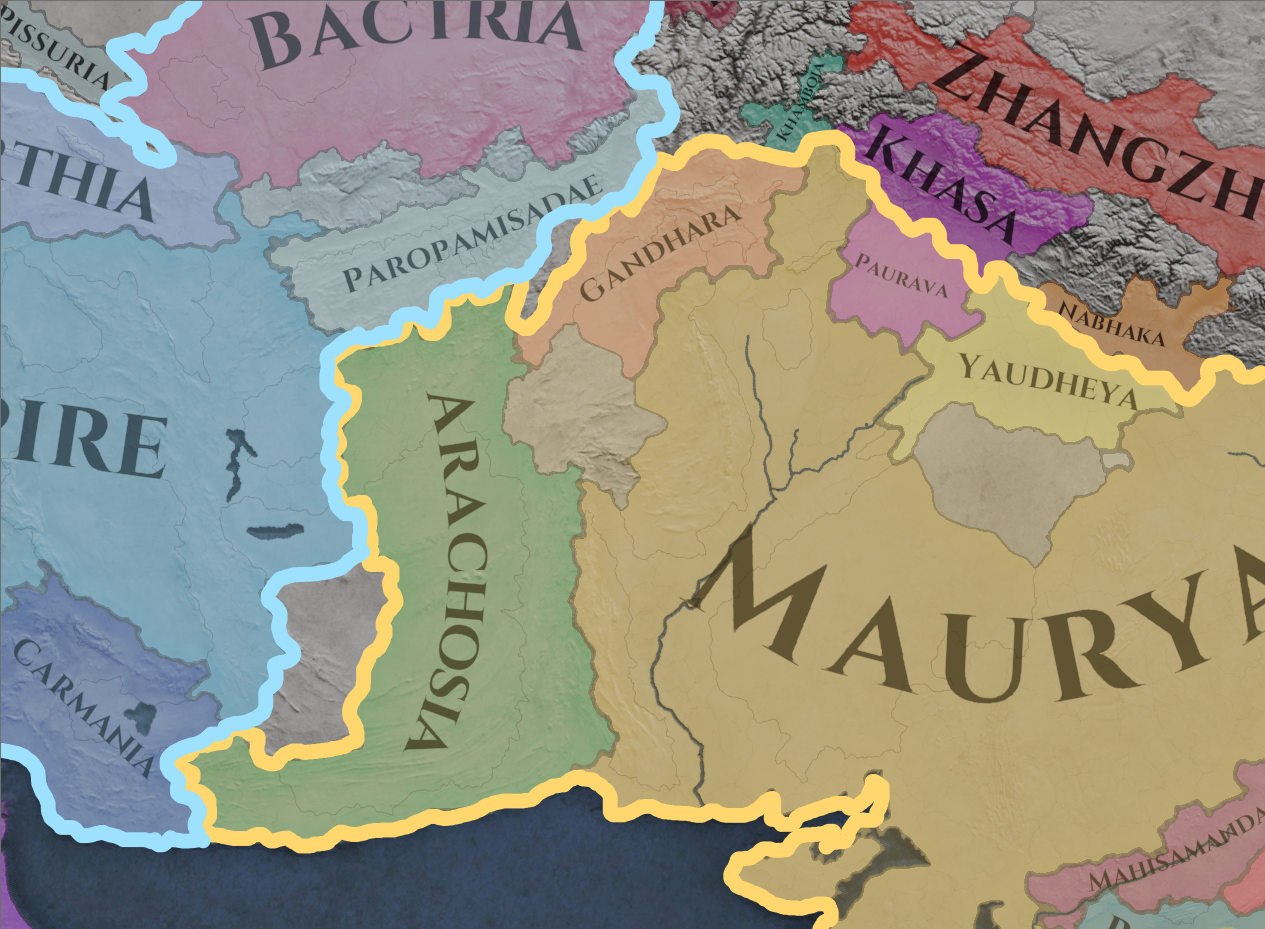
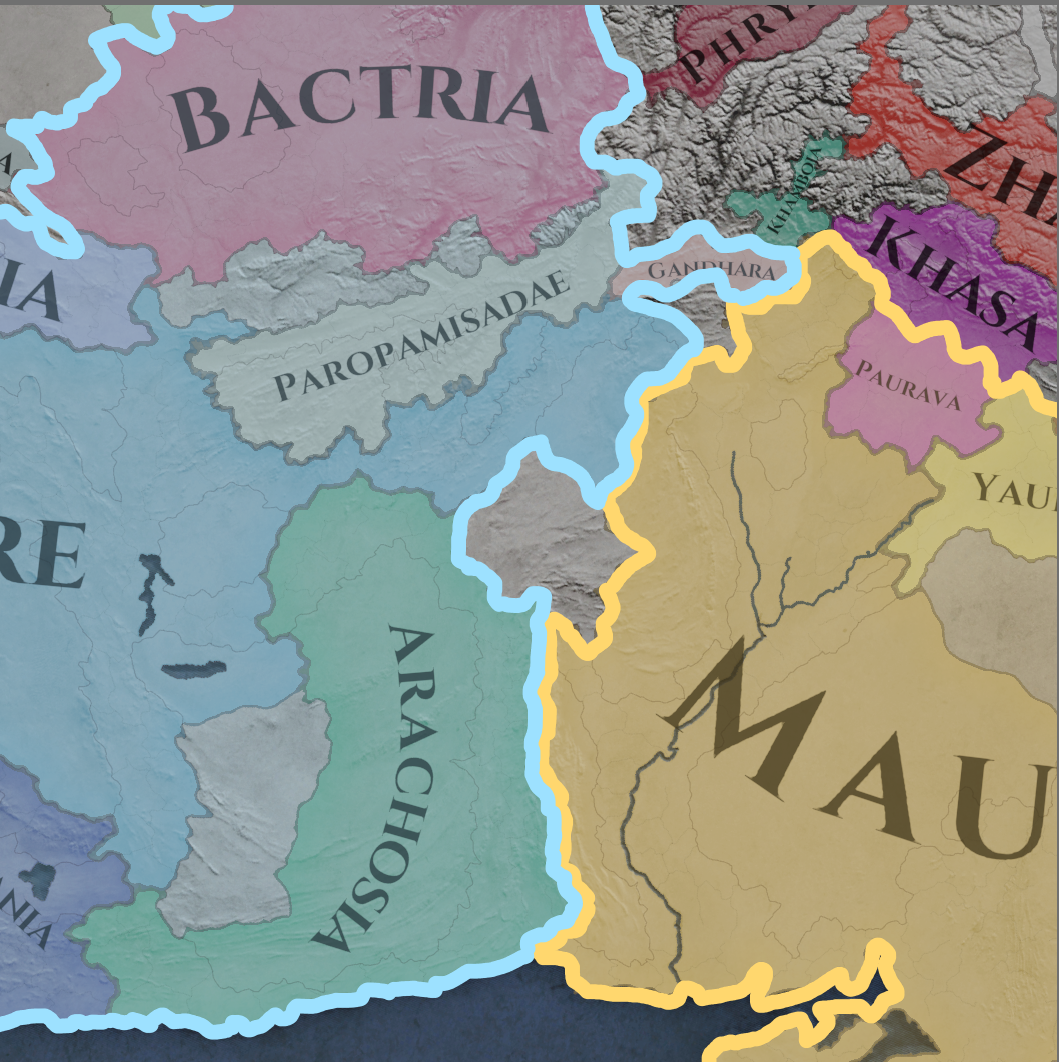
Change to Legacy of Alexander wars
One additional thing of note, Two-Coops developed a script that switches subjects during wars involving Diadochi. For it to work you need to fully siege (state capitals and forts at least) a subject of a Diadochi during a war - in a couple of days the subject will switch allegiance to you and get added to your wars. Obviously this fades along with losing the ability to declare wars with Legacy of Alexander wargoal.
Hiya, Anbeeld here. Patch 2.0.5 brought the big technical novelty – the ability to directly check values of most modifiers in the game with the modifier: syntax. For the AI it is very important, because it allows us to check various critical and previously unavailable data during the game, and these new variables can improve its decision making quite a lot.
The first change I would like to bring your attention to is the new “AI Recruiting More Mercenaries” game rule. While the name speaks for itself – and yes, this will definitely improve the strength of AI countries in wars! – there’s quite a few details to talk about.

At the moment I prefer to call this an experimental feature. It’s not just a few values adjusted in the vanilla recruiting algorithm, but a brand new, custom one instead. This allows for a full control of which mercenaries the AI will hire, but also brings challenges like checking if these mercs can reach the country in question, or if its budget can support their maintenance. Still, from internal testing it seems to work correctly in most cases.
Another point is how unhinged it can be, even completely draining the surrounding mercenary pool during active wars due to the AI really being into recruiting them to gain an advantage. This may also make the game pretty hard for players that are not that good with the war mechanics, as they may not be ready for such a resistance from AI countries.
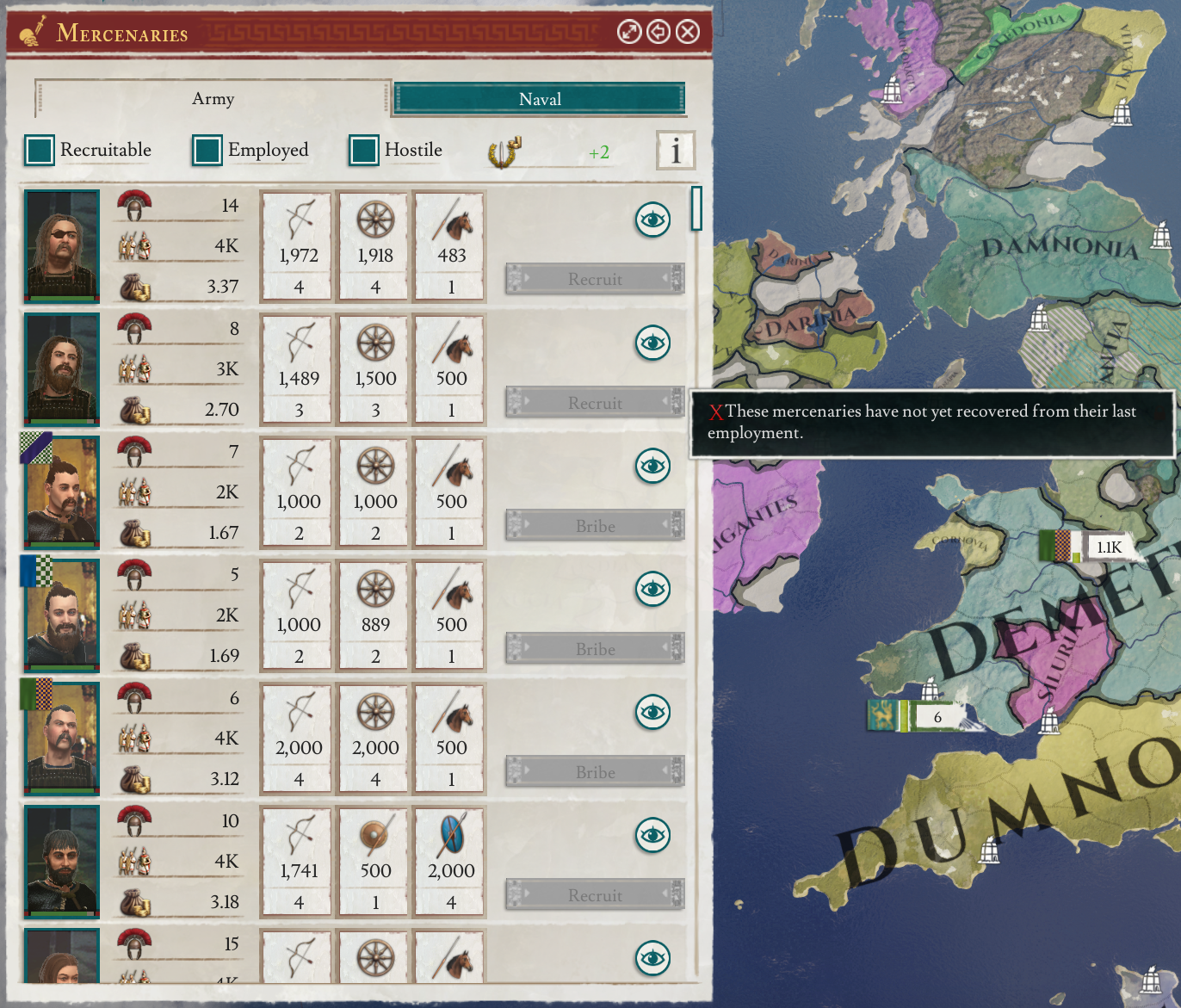
Currently this really is a feature for veterans who are bored from how easy the game feels. If this sounds like you, I would LOVE you to try the game rule and give your feedback. The feature being experimental means I’m quite open to making even drastic changes if needed, based on how players will rate its influence on the gameplay itself.
What made this all possible is the new modifier checking system mentioned in the beginning, as checking various data related to limits and economy simply wasn’t possible before, but now AI countries can easily fetch these values on the fly to make the correct decisions.
Another big change is the rework of how governors choose which policies to implement both in AI and player countries. My main intention was to increase efficiency of their choices, but character traits still play quite a big role too. The most obvious example is corrupt governors preferring Acquisition of Wealth policy to increase their own income over Encourage Trade, which is more beneficial for the country than for the governing individual.
Then there’s the Harsh Treatment vs Local Autonomy distinction. While Harsh Treatment is more effective at solving state loyalty issues, not all governors are capable or willing to do it. Characters with traits such as Merciful or Submissive won’t choose it by their own will, instead suggesting Local Autonomy as the policy they personally think is more appropriate.
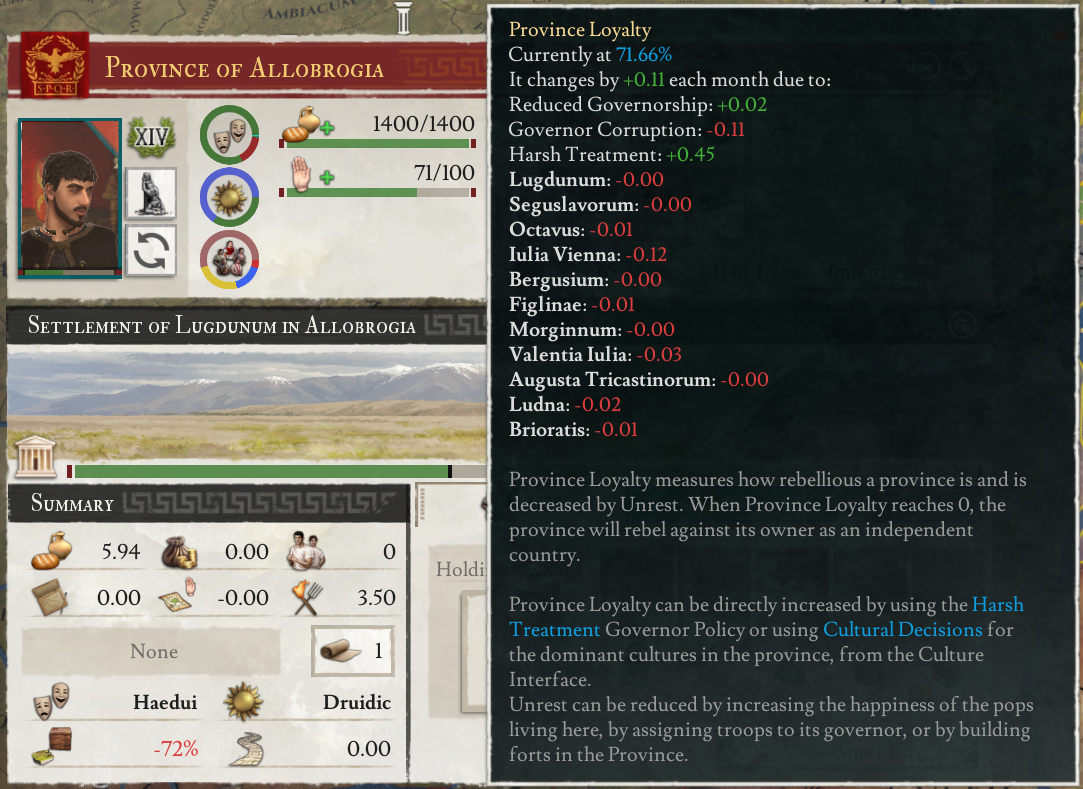
In regions where Religious Conversion and Cultural Assimilation are needed, pay attention to only appoint governors of country religion and primary culture, otherwise they’ll have no interest in implementing these policies. The same goes for disloyal governors, as they won’t be particularly fascinated about doing what the country expects from them.
Also be careful not to appoint a governor with a combination of multiple “evil” traits. This may not end so well for the population of the region under certain circumstances.
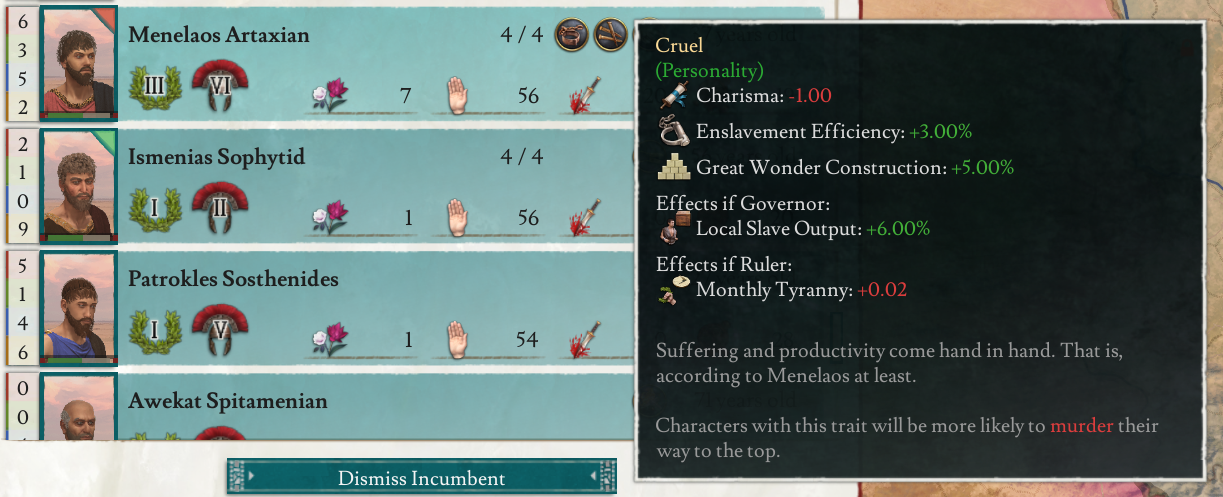
The new modifier checking system helped quite a lot here, allowing to get precise values of province loyalty monthly change from different sources, which is very important for taking measures at the right time and not when it’s too late. One caveat here is that governors don’t seem to change their policies too much after they choose one initially – a pity!
Another big change brought by it is the ability to calculate research efficiency of a country, something not possible before without burning player CPUs and bringing some really ugly stuff into the codebase. Yeah, you read that right, in previous patches it wasn't possible to check if the AI is at 40% or 175% research efficiency, which is a huge issue for decision making regarding buildings.
The consequences of this didn’t go unnoticed by some players, who started questioning if AI countries really need this many Academies. The answer is often they didn't, but without access to data there was no way of determining this during the game. As a compromise, back then I made them construct what I call “ratio” building based strictly on what rights the dominating culture in a city has.
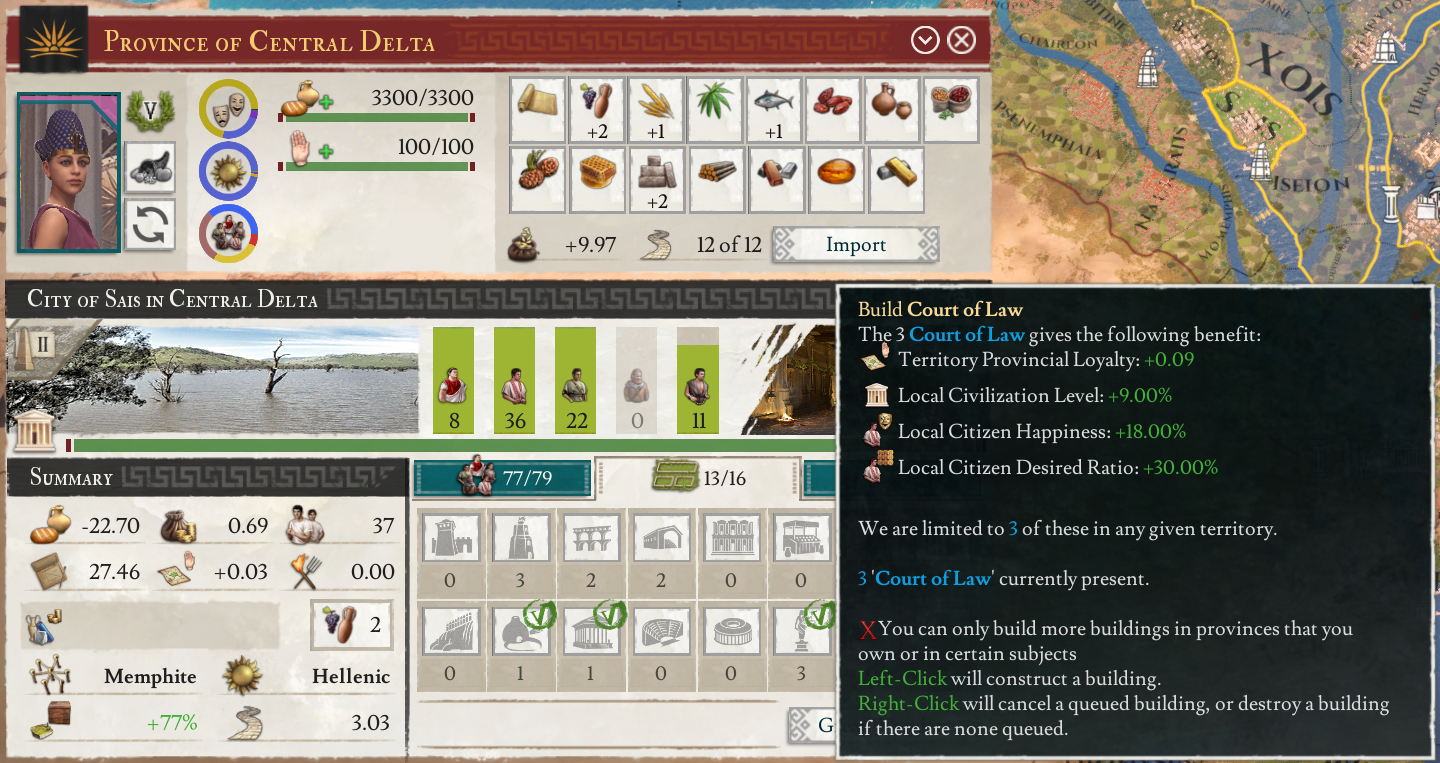
This means the AI always wanted Academies in cities where a dominating culture has Noble rights, Court of Laws if it's Citizen rights, and Forums or Mills for the rest of cases, based on how valuable the produced in the city goods are. For big AI countries this wasn't as bad, because they often had trouble reaching research efficiency cap even with such a setup, but for smaller countries this ended up being very suboptimal.
But now with the access to current and max research efficiency – and a few workarounds later, with damn levies reducing research points by an arbitrary amount – the logic got vastly improved. Now AI countries stop focusing their cities on Academy or Court of Law as soon as they have a decent amount of research. Specifically decent, as these buildings affect pop ratio and thus their effect isn't immediate, so the research will grow some more over time.
Instead they will start building Forums and Mills in cities that are still empty, which is “ratio” buildings focused on Freemen and Slaves respectively. This means more manpower and taxes instead of useless overcap research efficiency like it happened before, as well as lower food consumption and less issues with happiness. Hooray!
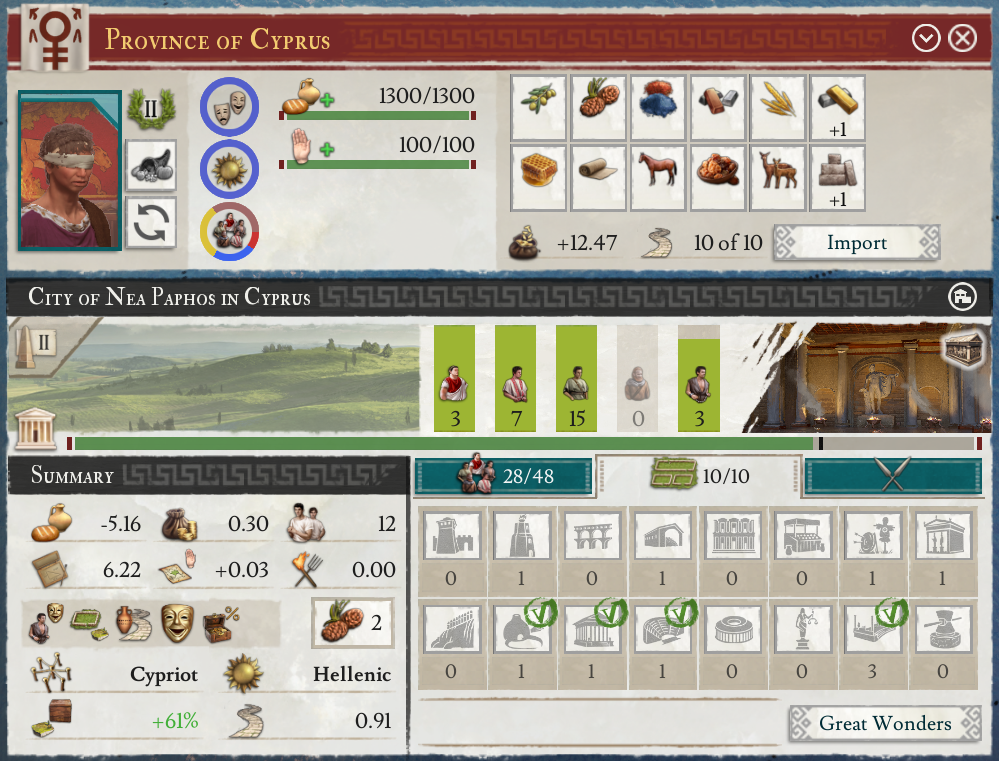
Now Library, a "modifier" building best suited for improving the output of cities that are already heavy on research, has some more relaxed rules, as its effect – on the contrary – is immediate. It's also much cheaper, and it raises the value of previous investments made into “ratio” buildings. Because of this Library will continue to get built until research efficiency comes somewhat close to the max value available to the country.
As mentioned before, small countries are the ones where changes will have the most impact. Single province Greek states like Crete won't build 5 cities filled with Academies anymore, but instead just one or a few of them, with the rest being focused on Forums and Mills instead. And if they end up having way too much research overtime anyways, I implemented the logic for the AI to use Harsh Taxation in such cases.
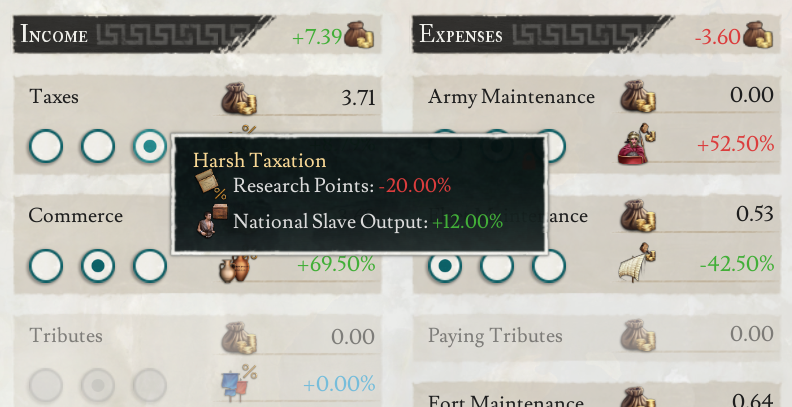
A number of other small changes and fixes were made, improving the overall performance of the AI. For example, it now has a very high priority on building Farming Settlements in states with a lot of buildings, which will hopefully forever stop Latium from starving. Logic related to constructing Aqueducts was improved as well, which will result in a higher amount of metropolises built by AI countries in the later stages of the playthrough.
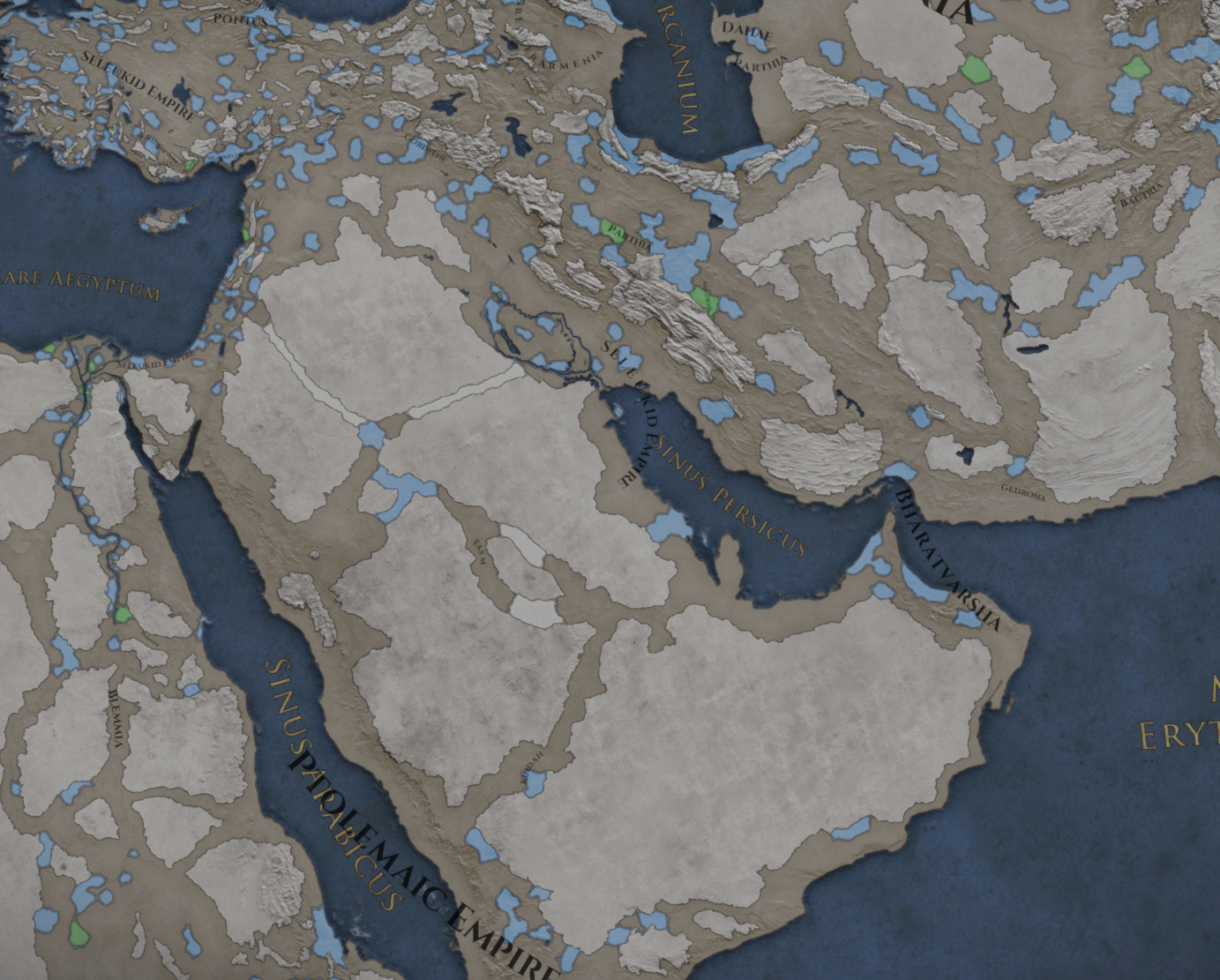
Beware of this very thin, but very tall Parthia! It will, eh… research faster than you!
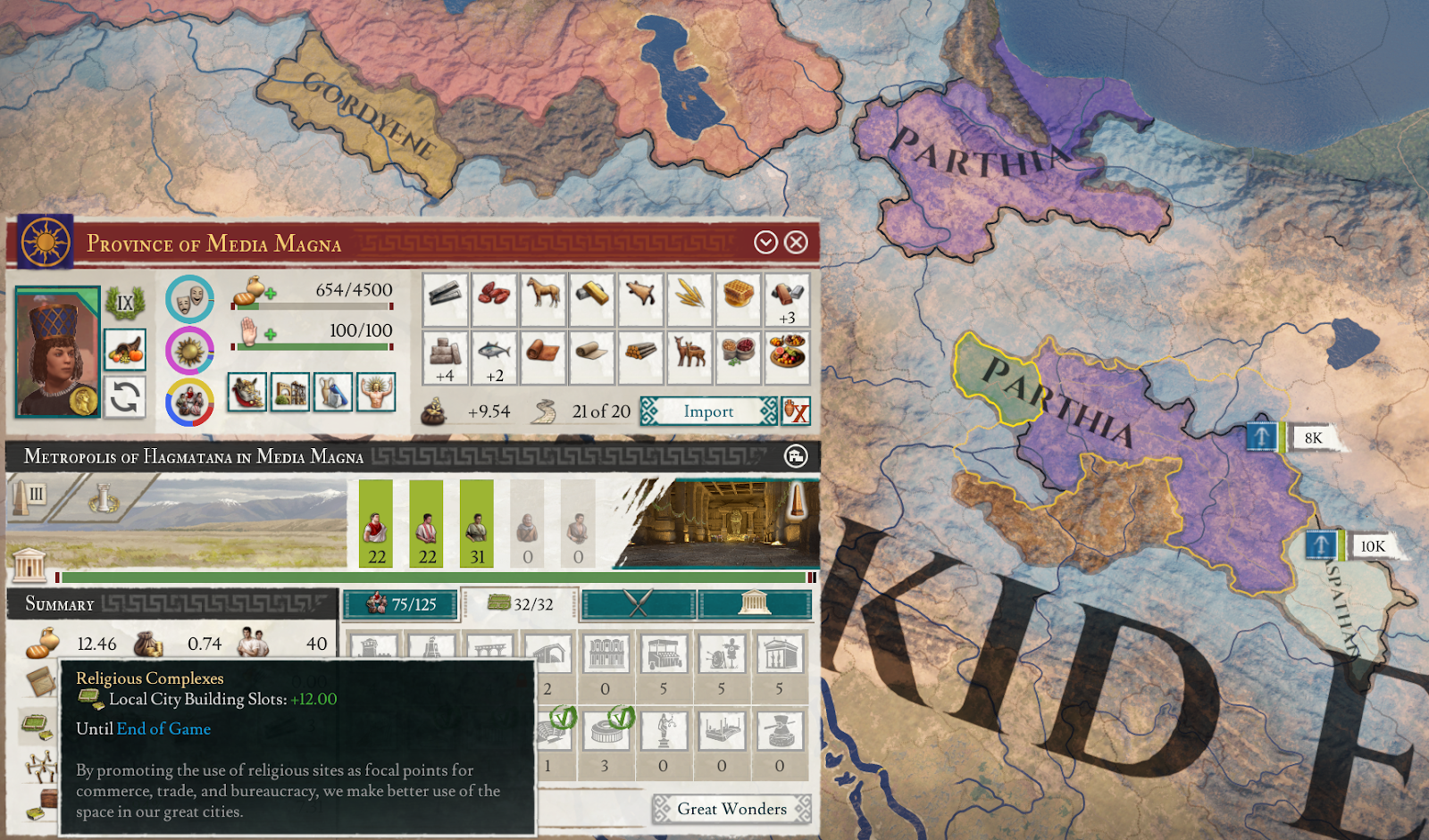
Very tall, I tell you! Maybe a bit hungry as well, but it’s hard to research with a full stomach.
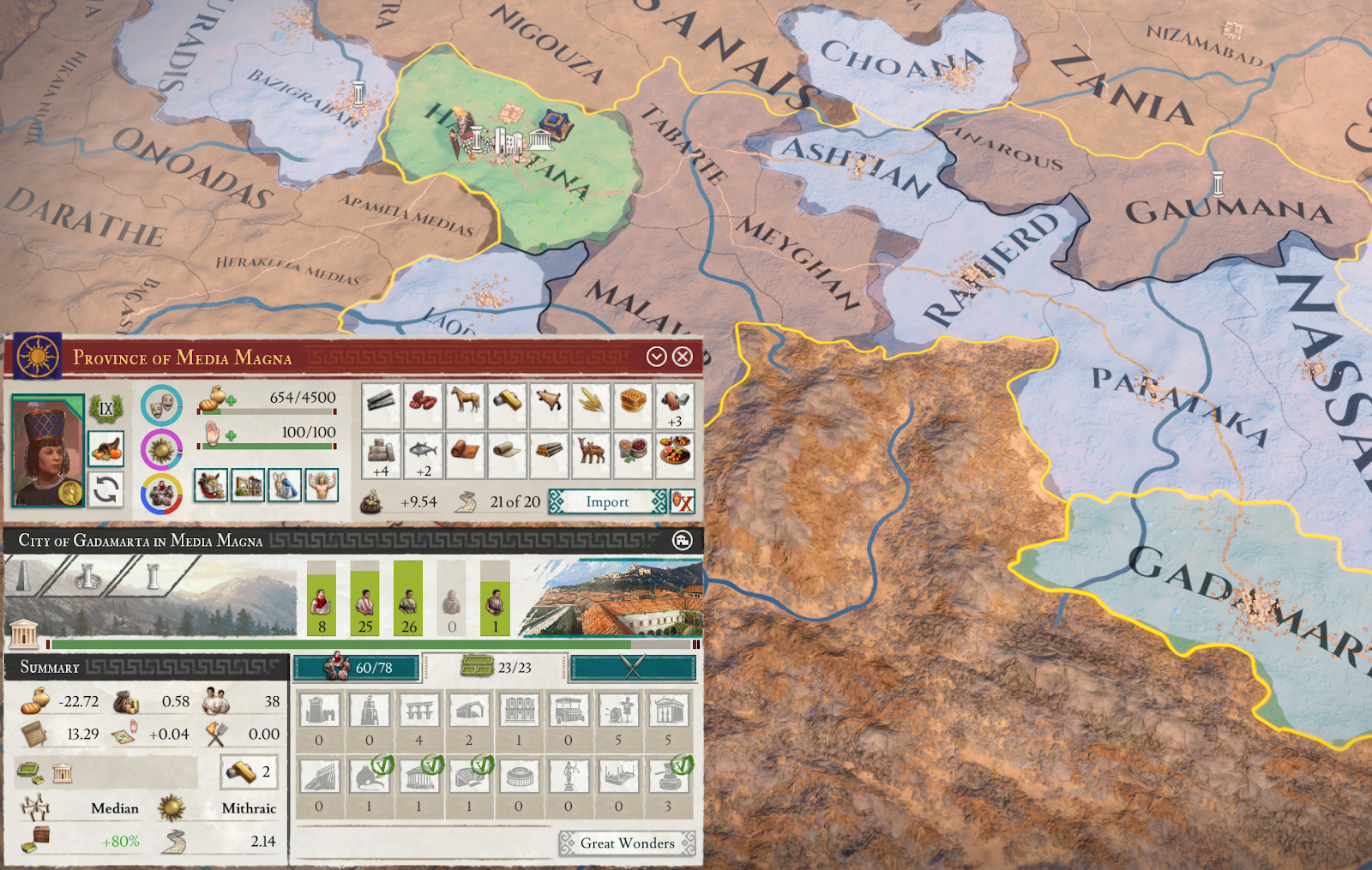
I also re-enabled inventions to become Dictatorship for AI countries, as they stayed dormant for a few patches since AI reworks started. Great powers like Rome have quite a decent chance to take them, while for major powers the probability is much lower, albeit non-zero.

Many improvements were made to how the AI manages economic policies like Army Maintenance, Wages and even Tributes, saving money when possible and gaining subject opinion when it allows to integrate them.
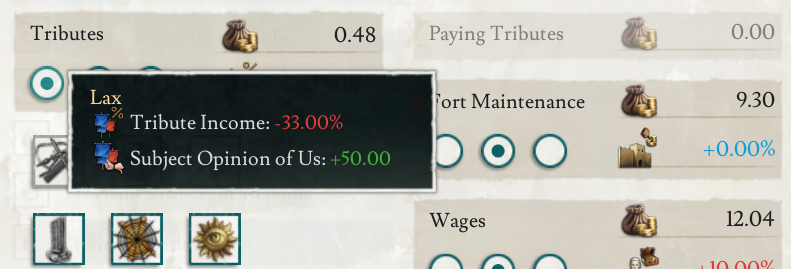
These and other improvements and fixes should bring just a bit more oomph into your late game boss fights against AI opponents. Hope you enjoyed it and see you later!
Ave Imperator. Today, I, Supermash, will show you a little improvement we did for Casus Belli.
As you may know, Casus Belli is used to declare wars on your opponent. Select a war goal and then fight.
We have actually five main types of Casus Belli :
All these types of Casus Belli have different war goals and most importantly, what we will discuss today; the war cost modifier for each of them.
Before, many of these CBs were extremely outdated and some were left untouched from vanilla since the game launch! The results made all CBs except the conquest one not really viable. Here’s a little look;
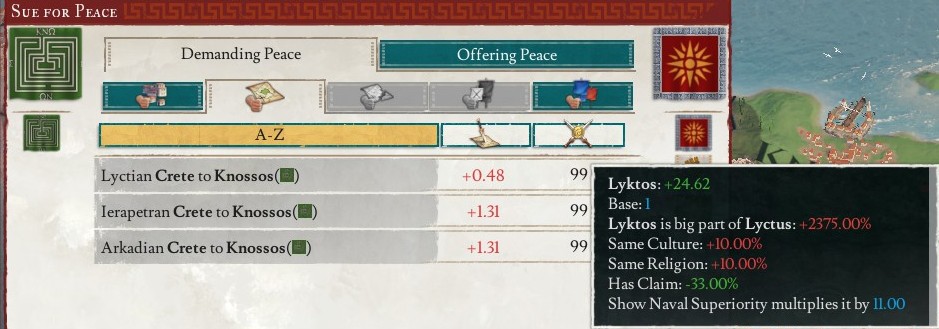
Naval Casus Belli vanilla
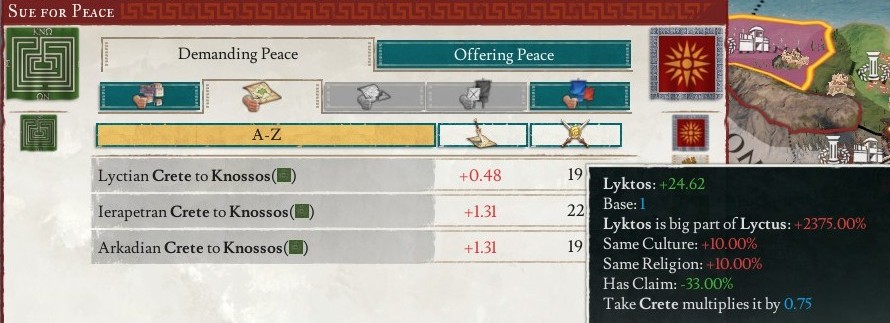
Versus the same war but using the conquest Casus Belli instead.
We can see that if you use the Naval Show Superiority, everything will cost 99% of war score! On the other hand, using the classic Conquest CB would place the value at a reasonable range. Why is there such a vast difference? Simply because a small value that is multiplying the base war cost of every peace option.
It is time to clean up a bit of this old dust and to rearrange everything.
First we will harmonize this multiplier for every type of Casus Belli as it was different between two similar Casus Belli.
The values are now the following :
Some specific CBs, like the Mauryan Collapse, will get their own values too.
The results are immediate. Alternative war goals can now be used for specific occasions. Let’s say you are a Punic naval trade empire and you want to challenge nations in Sicily. You could use the show naval superiority war goal instead of the direct conquest one, showing the strength of your navy!
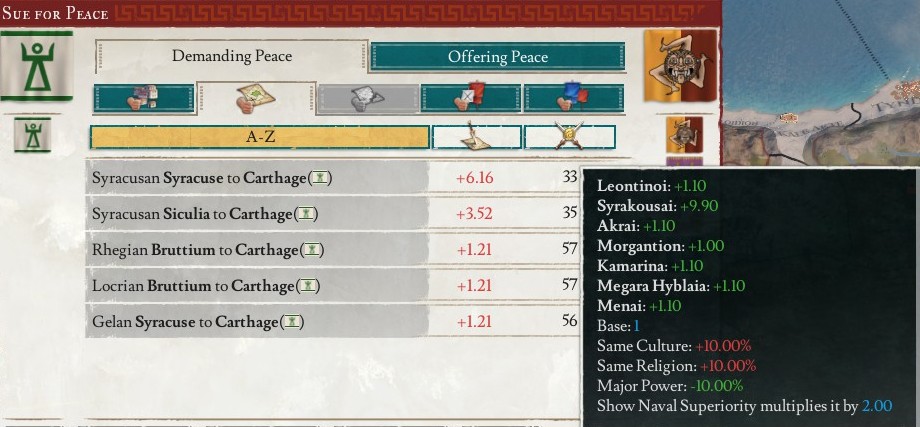
In a war between Carthage and Syracuse, we can still fully annex them in one war with the Show Naval Superiority CB. It is still more expensive compared to the conquest one to compensate for the alternative win condition of this war.
Maybe you had noticed earlier, but the Conquest Casus Belli no longer has a reduction of -25% of the war cost.
This means the speed of conquest is a bit slowed between two major nations. It will be easier to recover after a loss of territory as the amount of base conquest will be reduced… unless you decide to invest into war cost reduction or get a claim which gives -33% war score cost.
And one last point. What if you forget or don’t read these Developer Diaries and you don’t wanna test each Casus Belli to know this modifier ? Do not worry, for I have the solution.
We updated the description of each Casus Belli to include this modifier. You will be fully aware of the potential cost for using one Casus Belli instead of another.

Salvete!
Today we'll be talking about tons of new content and missions for Parthia and its many variations including the Dahae and Indo-Parthia.
We'll also be further presenting more AI changes by Anbeeld and some smaller changes made to the Casus Belli's.
But first, the 1.10 'Arsaces' update is out now, you can download from here:
Steam: https://steamcommunity.com/sharedfiles/filedetails/?id=2532715348
Nexusmods: https://www.nexusmods.com/imperatorrome/mods/1?tab=files
To continue old saves, unsubscribe and remove the mod. Then download the 1.9.2 version from Nexusmods: https://www.nexusmods.com/imperatorrome/mods/1?tab=files. Nexusmods does not automatically update so make sure to remove this version and resubscribe once you have finished your old save.
Now onto the patch notes!
V1.10 - Arsaces (breaks saves, use Nexusmods 1.9.2 version to continue old saves)
New/expanded mission trees:
- Added new large mission tree and mechanics for Parthia
- Reworked/Revamped every Germanic tree
- Added new mission trees for the Horn of Africa countries
- Added new missions for the Dahae tribes, the satrap of Parthia and Indo-Parthia
- Added new missions in the Caucasus for Legia, Zygia
- Added new mission tree for the Androphagian Man-Eaters
- Added new missions for Arvernia and Salluvia
- Added new mission tree for Blemmia
- Added new mission tree for Caria
Map changes:
- Reworked the map setup in several regions including Anatolia, Cyrenaica, Greece, Iberia and Italy
- Added new Nartic faith around the Caucasus
- Added new Blemmye culture
Added content:
- Entirely reworked the Parthian invasion
- Added new content surrounding the Mithridatic kingdom
- Added new Attica, Bastetania, Hindustan, Lesser Media, Macrobian League, Pannonia and Upper Cilicia formable
- Added Temple States as a new subject type
- Added Ability to Go Raiding as a Character Interaction
- Added several new flags to Germania and various other regions
- Reworked Levy Templates of minor cultures in Anatolia
- Added historical character/family names to various cultures
- Added new deities to various religions
- Added lots of new event pictures and implemented them into existing events
- Added/rebalanced a dozen heritages
- Added several new cultural inventions for the Caucasus cultures
- Added ability to build Pirate havens for Pirate countries
Changes:
- Touched up Armenia's mission tree with standardized culture points mechanic
- Adjusted various missions to the new map setup
- Rebalanced Albion's tree
- Nerfed conquest CB to give parity to attacker and defender
- Reworked the land and naval wargoals to be more useful
- Updated German translation
- Added new partially complete Russian translation by Zavarin19
- Reworked the countries with missions GUI
AI Changes:
- Added experimental "AI Recruiting More Mercenaries" game rule that makes wars against AI countries significantly more challenging
- Disabled AI migrations temporarily due to 2.0.5 vanilla bug where migration armies get swiftly deleted by the AI, removing the country from existence
- Reworked how governors choose their policies, making their decisions more optimal, but also with more influence from governor traits
- AI countries can now use Harsh Taxation if their research efficiency is above the cap
- AI will now heavily prioritize building farming settlements in states with a lot of cities, saving them from running out of food
- AI now takes current and maximum research efficiency into account when choosing buildings and inventions. Once a country reaches high enough research efficiency, it will prefer buildings that promote Freemen and Slaves instead of Nobles and Citizens, leading to higher tax income and more manpower
- Improved AI priorities regarding aqueducts and metropolises, leading to higher amount of them in AI countries in later stages of the game
- Reenabled inventions for transforming into dictatorship for AI countries. Great powers (think Rome) have quite a decent chance to take them, while for major powers it's much lower, albeit non-zero
- AI can now use Lax Tributes economy policy to improve relations with subjects they couldn't otherwise integrate
- Improved AI decision making regarding Increased Army Maintenance and Increased Wages economic policies
- AI countries now actively use Unit Reorganization ability on low morale mercenaries to reduce the time it takes for them to be ready for battles
- Disabled Municipal Self Rule and Grant Clan Autonomy for AI so they don't lose territories
- Lowered early game Armenia aggression
- Slightly lowered the aggression some traits give
- Civil wars no longer trigger if under 5 territories to prevent unwinnable civil wars for AI from triggering (up from 2)
Bugfixes:
- Updated files fully for 2.0.5
- Fixed Fortify Province investment not giving +1 fort limit due to vanilla bug in 2.0.5
- Fixed a number of broken mission requirements
- Fixed training characters potentially instantly cancelling
- Fixed macrobuilder showing too many tabs for several buildings
- Fixed many cases of bad indentation
- Fixed several poor triggers and effects on vanilla missions
- Fixed lots of edge-cases and bugs on existing missions
- Replaced is_port = yes checks with num_of_port_building >= 1
- Cleaned up old, outdated and disabled content
- Fixed a ton of spelling mistakes, loc errors and bad grammar
For the Dev Diary and the Parthian content, i'll start by handing you off to Peterson.
Hi all, Peterson here with stuff I hope will be interesting.
As many of you, I was always a bit taken aback by lack of Parthia-related content - Invictus adds a lot of extensive and cool stuff throughout the map (Albion, Cyrenaica, Bithynia for starters I think are gold-standard), but whatever content there was for Parthia was, by comparison, well, lackluster. As such, after three years of playing this game, I decided to do something about it.
Saying I did is a bit misleading - many, many thanks to absolute legends Zorgoball, Duart and Izn for doing the beautifully written localization, Chehrezade and Siya for content ideas and research, Zamensis for letting me steal bits and pieces of his code. Nevertheless, if I counted the hours I spent doing all of the stuff that I'm about to show off, frankly I’d probably be appalled.
Historical context
For some quick historical perspective - the Parthian Kingdom/Empire that y’all might be familiar with came about because of a nomad invasion into Iran (not too dissimilar to the Seljuks many centuries later). The guilty party were the Dahae tribes under the leadership of Parni chieftain Arsaces. The Seleukid satrap of Parthia, Andragoras, declared independence in the 240s BCE and the Dahae were quick to take over that land. The Dahae apparently quickly adopted Parthian language and customs.
30 years later, during Antiochus III the Great’s eastern campaign, Parthia submitted again to Greek overlordship, now under its new, non-Greek, dynasty. The Arsacid dynasty proved to be tenuous subjects though, and conflicts and raids persisted, with consecutive territorial gains. True breakthrough came about during Mithridates I’s rule, in 140s BCE, with sweeping territorial gains resulting in what you roughly might think of when you think of the “Parthian Empire”.
The Arsacid dynasty generally ruled with a light touch, preferring to have many subjects, and assimilation into Parthian culture was not generally the focus. As such, transforming all of this history into something Imperator:Rome can manage has led to many interesting solutions.
How it used to work
Until now, Parthia was just taken care of content-wise by an event that triggered roughly thirty years in-game, which:
- gave some buffs/debuffs to relevant parties;
- declared total conquest war on Seleukids (totally unhistorical; even if you consider Mithridates I’s campaigns as being in I:R terms with “imperial challenge” wargoal);
- killed the Seleukid ruler (idk why, probably to destabilize Seleukids further for easier conquests).
Invictus added an event that triggers a bit later that allows you to convert to a chosen religion.
This is essentially all totally gone, considering that, in light of what happened historically, it was nonsensical. Now, onto the main course(s).
Dahae Belligerency Situation
When playing in Iran/Mesopotamia, roughly half a year into the game you’ll be greeted by an event that starts off a situation not too dissimilar to the EU4 Nomadic Frontier disaster. This is essentially a slider that ticks up/down depending on set circumstances.
Viewable from the decisions tab (it was decided against doing a separate screen, similarly to how CK3 handles this type of content) and well, everything should be self-explanatory when seeing the screen. If the slider goes to 100, then the Dahae Invasion will happen as it would in vanilla, also roughly thirty years into the game. Essentially this design ensures couple of things:
- unless you really try to make Dahae pops happy, you’re going to get wrecked as a Diadochi/taken over as satrapy Parthia;
- now this steppe invasion is not really tied to Seleukids, if you win the Diadochi Wars as say Antigonids then I can only wish you good luck;
- cheesing prevention of the invasion by conquering all Dahae tribes won’t work now, obviously;
- cheesing weakening/prevention of this event by freeing satrapy Parthia to conquer it manually won’t work either.
If you resolve the situation peacefully though, all countries around Iran will sigh in relief and get some stability, including yours. This might come in handy when playing on satrapal Parthia (“Greek Parthia”), because if situation progress reaches 100 when playing as them, you’ll get tagswitched to post-nomadic Parthia (“Big Parthia” or just “Parthia”).
Greek Parthia mission tree
Starting on this country you’re looking at a mid-size mission tree with 2 mutually exclusive paths: let’s call them Loyal and Independent paths, correspondingly on the left and right above.
Loyal path is in all honesty reskinned Cappadocian loyal-to-Antigonids path (I know Eumenids and Cimmerians get all the spotlight on this country, but the loyal path is an amazing piece of content…like the whole tree btw).
Tasks revolve around:
- conquering Dahae tribes up north;
- getting up-to-date in development (you start with 4 innovations/1st tech level - rest of the Greek world starts with 8 innovations/2nd tech level);
- sending some gifts to the Overlord (rewarded with some bonuses and some neighbouring territory);
- winning battles in the Overlord's wars (Hyrcania as a reward). Overall, before the last 3 branching mini-paths, you’ll end up in control of the whole Parthia region.
Then the choice is to either: (i) really stay loyal (and become a March, a new subject type - will be described later), (ii) become a more local variant of the Greco-Parthian kingdom or (iii) take up the mantle of a new Diadochi (you’ll get a dynastic name for the country and access to Hellenistic Empire mission tree).
Being on the March path additionally lets you smear Bactria’s reputation in front of the Seleukids and declare war on them, to become the sole northern flank of the Greek world (Yaudheya content).
Mind you again, if you can’t resolve the Dahae Belligerency Situation peacefully, you’re gonna lose access to everything here and switch to Big Parthia mission tree.
Independent path, as you might expect, is designed to quickly lead you to independence and as such get you tools for this goal.
Your levy will get transformed into a legion, which you’ll have to drill. After reaching certain readiness, you can go for the expected David vs Goliath scenario and strive for freedom (Bactria can be enticed to declare independence alongside you, but the Seleukids will be preoccupied with attacking you). The goal is to become a proper Diadochi in place of the Seleukids and continue to reform the Hellenistic Empire via its mission tree.
If you build fortresses near the Dahae tribes, you can meaningfully guard against their takeover. By which I mean you’ll get either a choice to be taken over, or choose to fight. The invasion in this scenario will be greatly weakened, so you actually do stand a chance.
Dahae Mission Tree
Small-ish tree with also 2 mutually exclusive paths (say “Conquest” and “Diplo” respectively). Start your game as either one of the Dahae tribes:
- Parnia;
- Zanthia;
- Pissuria;
- Attasia;
- Derbicia.
Attasia and Derbicia are not really Dahae, they’re Massagetae, but vanilla requires their territory to unite the Dahae tribes. I’ve decided to keep this in place so the unification process isn’t just involving two other tags, as that’d be lackluster. You can make a headcanon that they’re very close culturally to Dahae due to proximity.
How the Conquest path works and what’s behind those tasks is pretty self-explanatory I guess. Doing them gives some small local rewards and slightly boosts your Ruler’s skills with a focus on martial, and at the end you can get some manpower back to facilitate even further conquests.
The real gourmet part is the Diplo path - if you can’t be bothered to race around with your disheveled clan armies, you can unite the tribes this way. Path slightly boosts your Ruler’s diplomatic skills and stuff to do includes, among other things, e.g.:
Ck3-style hunting event-chain - get other rulers to gather and go for some falconry and drinking. Networking is very important, as every third post on LinkedIn will remind you.
Hoi4-style imperial conference event-chain - if you did your part to try to convince other chieftains to agree for uniting the tribes into the Dahae Confederation, you can do a diplomatic summit in which, depending on the diplomatic opinion and friendships, other Chiefs will agree to unification. During the Conference you’ll also discuss some pertinent issues and, depending how many tribal leaders agree, all accepting tribes will get couple scaling bonuses.
All other tribes must agree, however, and should the Conference fail, you get claims and can always go for the obvious direct alternative.
Anyway, both paths lead down to formation of Dahae (duh) and renaming your ruling family into the Arsacid Dynasty.
Big Parthia mission tree
Upon the conclusion of the Dahae tree or getting switched over from Greek Parthia to Big Parthia, you access this monstrosity. Around 90 tasks, but in reality it’s 130 different ones, you’ll see later (and hopefully in a couple playthroughs!) why there’s a giant discrepancy.
First couple of tasks mostly concern preparation for further conquests:
- entice governor of the Greek Parthia to rebel;
- start a one-year war against Bactria; if you hold Alexandria Margiana at the end, you get the relevant area and Bactria gets cut off from their overlord (will get independent with your war against Seleucids);
- alternatively, or if you fail the raid mentioned above, befriend the Bactrians to also entice their independence later.
After Greek Parthia gets independent, you can swoop in and annex them. This allows you to actually form Big Parthia/Parthia, and one task resettles your pops to the region; some land gets left for a Dahae tribal vassal, and land further north gets split into area-based tribes (alternatively your Scythian ally gets them).
This gets you to a very important decision that’ll shape the rest of the campaign - will you wage an imperial challenge war against Seleukids or fight a normal war? Your decision correspondingly changes the Branching Missions - as shown above - into either Imperial WG missions or Conquest WG missions.
Imperial WG missions stem from the fact that using mechanics of this wargoal you’ll likely conquer most of the Seleukids in one war, so not differentiating between that playstyle and playstyle from cutting Seleukids piece-meal is just dumb. Also represents historical decentralization of the realm and balances it out with normal war option; obviously IC-wars will always be faster.
Key point here is that after the war, you’ll be able to hold only 3 regions directly (historically known as Dastgerd). You get to choose which regions, and for example choosing Mesopotamia+Media+Parthia gets you the result above (Parthia gets bulked out a bit for historical borders). Regions must border each other, but every couple of years you can switch them out if you so wish. Biggest culture in a chosen region gets automatically integrated.
What you can’t hold directly will spawn a March - new subject type, that gets you some monthly military experience and itself gets defensiveness bonus. It can declare external wars and is not diplo-annexable, differentiating it from satrapy. Those are purple things in the picture above.
Additionally during this war Osroene, Elymais and Characene might get free (later request March status so you’re not incentivized to murder them) and Seleukids might ask for peace in exchange for leaving them alive in Syria, which will net you some tools to manage your new giant landmass better and even the hand of a Seleukid bride. This is designed to be a worthwhile option to get you to historical borders on the Euphrates and not kill the Seleukids entirely.
When on this branch, the goal is to get this gov ability slider (viewable in a decision tab) to a 100. That slider, which you might recognize from extensive use in EU4, gives scaling down law enactment cost, to ease the burden from reforming from your nomadic roots. Rules of up/down ticking are probably self-explanatory, but mind you, because of monthly passive military experience gained from having Marches, it might not be too wise to rush the process.
To help you with centralizing Marches, mission tree leads you down converting them to your culture and religion, also you need to appoint members of your family as their rulers. If you get the slider to 100 one thing remains to be done - fight off a big civil war, akin to Roman/Hellenistic Empire ones. After this, you function as a “normal” country, with some bonuses thrown in for your trouble and namechange to Arsacid Empire (or Parthian Empire, if you f’d up somehow keeping those guys in charge).
Other tasks concern bowing your neighbours into submission - you can request they become Marches. Whether or not they bow is opinion-dependent, and each gives a timed modifier based on their heritage. If they don’t submit you get claims but again, mil XP in this game doesn’t fall out of the sky so it just might be better to be diplomatic. For the Armenian subjects, Gordyene and Sophene, you’ll have Cyrenaican-style decisions to steal them from Armenia (in that case it was for Delian League, in conquest of the Aegean mission tree).
Alternative to using Horde Conquest wargoal and Imperial WG missions is always to cut Seleukids piecemeal. Missions here should be quite self-explanatory, and some tasks for requesting submission double from Imperial WG missions.These missions converge with Imperial WG missions on having formed the Arsacid Empire, albeit here without the civil war and with less bonuses.
Grind never stops however - you need to surpass the Achaemenids, or at least achieve parity with their glory.
This gets us to another Branching Missions - this time for different religious paths, courtesy of Izn. Current selection includes Mithraic, Zoroastrian and Hellenic sub-trees. Selection is performed via appointing to the office of High Priest a guy of the religion you want to convert to (guys spawn from one of the preceding tasks).
Salam and hello! It’s been a while, this is Izn speaking! As Peterson mentioned, I worked on the 4 religious branches of the Parthia tree. I’ve included everyone’s favorite: religious controversy, syncretism, and conversions. Let’s start with Mithraic.
The Mithraic path has been designated as the ‘historical’ path, which is a controversial choice for sure. Regardless, I’ve tried to make sure there’s plenty of syncretism and cobelief with Mazdayasnan (Zoroastrian) belief as well. There’s a whole path of Mazdayasnan based religious flavor, and my intention is to make the player feel not like they are following a wholly different faith, but a different version of belief. The Mithra side of the tree is filled with reverence and symbolism of the Lord of Light, who the historical Parthians had a huge emphasis on (ultimately the reason we went with Mithraic as the ‘historical’ path).
The Zoroastrian path, or rather, the Mazdayasna path emphasizes the role of Ahuramazda over Mithra. But Parthians being Parthians hardly follow an orthodox version of Mazdayan belief. They’ll still worship Mithra and keep Median influences, just with a caveat that it comes through and beneath the Wise Lord’s will.
The Hellenic path is filled with syncretic deities of all different faiths. As a minority religion, the narrative describes how it becomes somewhat of a prestige religion, before ultimately becoming a strange amalgamation of Zoroastrian and Hellenic traditions. The map may not show just how syncretic the religion of the Parthians is, but hopefully through the tree and your pantheon, you’ll feel like you aren’t truly one faith or another.
The Buddhist path was sort of a personal project, unlike the other faiths, this path is probably the least historically based. There are a few sparse claims that Buddhism had somewhat of an impact on the eastern nobles of the Parthian empire, however there’s not much to go off there. Instead, you’ll enjoy a lot of Irano-Buddhism found across Central Asia and the Indus Valley. One unique thing about this path is in order to become a sage (Apotheosis), you will need to reach Nirvana-in-Life, not an easy task, but certainly rewarding. Anyhow, back to Peterson!
Additionally, courtesy of the GOAT Shinymewtwo, Zoroastrian, Hellenic, and Buddhist paths grant you new flags (standard Parthian flag has a Mithraic symbol so it obviously clashes; leaving it intentionally as a default though since most of the Parthian pops are Mithraic so it’s still adequate).
Another sub-branch concerns political developments, for example:
- first mission changes your great families to Parthian Great Families. This means they get new surnames (Suren, Karen (yes, funny ik), Mihran) and parthian culture;
- ability to choose Spahbed (gov guy that gives monthly XP) to be “hereditary”. I:R won’t support hard-limiting choice to only one family, however if you decide to go with this possibility every appointed family member to this office will get his martial skill boosted; anyone else appointed will make that family really angry and he’ll lose skill points;
- you gain ability that almost completely negates penalty to population capacity in cities in desert terrain. This includes present and future cities at the time of clicking the mission;
- choosing proper capital placement (so not necessarily Ctesiphon), alongside placements for sub-capitals, like for coronations and treasury. Represented via differing local modifiers.
Last sub-branch concerns economic developments, which among many other things offers:
- chances to change trade goods of some provinces to relevant ones (olives, metals, salt);
- connecting existing road networks, so that the Mediterranean world is better connected to India;
- developing rug and clothes production. Also allows changing trade goods to relevant ones, and at the end you’ll be swimming in income from this lucrative industries (not too dissimilar from Eu4 Persia rug production rewards).
And last but definitely not least, here you have a going along the Silk Road event-chain, a la Albion travel (but linear, because well, it’s a road-based voyage, not an open seas-based one). Just like Albion's trip, you'll have 1,000 gold coins to play around with as you stop at various cities along the trade routes, with a total of around 30 events to enjoy.
You can even follow your traders on the map a bit! Obviously not all the way to China, as the map ends where it ends.
As to what’s there content-wise, I’ll let you all find out for yourselves because even beginning to describe the amount of content there is a futile task. Let’s just say that for example you can have a Byzantine monk moment and steal some silkworms for domestic production.
Indo-Parthia mission tree
Historically Indo-Parthian kingdom was formed by the governor of the in-game Ariana region, Gondophares, likely of the house of Suren, just at the tail-end of I:R timeline. But hey, if it’s in the game, they can also get something cool.
When playing as Big Parthia, you can form Indo-Parthia in 2 ways:
- move your capital to Ariana or one of the Indian regions; or
- if you have a subject in the Ariana region eventually you’ll get an event that allows you to switch into that subject of yours.
Works for both conquest paths, you just need to do tasks that set your religion in place and spawn the Parthian great houses.
This obviously also means that Big Parthia, your former country, goes to AI.
Choosing to form Indo-Parthia from Big Parthia skips some things, so I’ll focus on the switched-to-subject gameplay.
First things first you’ll need to request a governor from one of the Parthian great houses. This comes with access to more funds, as that governorship is but one of that family’s assets - for the time at least.
Then, since you’re a March subject, you can go conquering east of you. Obviously the biggest obstacle is the Mauryans, so it might just be worthwhile to wait for their collapse (or help them expedite the process). Eventually, after conquering the Indus river valley, you can click the Indo-Parthia formation decision, which also will make you independent. Be warned though - your former overlord just might request lands you possess west of the Hindu Kush mountain range (so essentially Ariana and Bactriana regions), depending on your relations.
After formation, relevant for it task gives you quite unique rewards:
You can now go ham and become the Mughals of antiquity. I assume it’s a country 5 people will ever play, so just wanted to add some fun stuff that’s unique and not labour intensive, such as:
- access to Horde Conquest CB - this is essentially an Imperial Challenge/Legacy of Alexander-type war that lets you conquer, but usable against anyone;
- some bonuses for elephants, so you can stomp your enemies efficiently under their hooves (e.g. they’ll move as fast as infantry now). Also your levy template gets swapped to include elephants.
Historically Indo-Parthians got independence easily and were seen as equals by the Arsacids, and friendly relations persisted - this can be replicated, and as long as both countries hold positive opinions of each other, both can prosper.
And this concludes content additions for my own little Parthia DLC. Complaining “where the Parthia content at” is henceforth invalidated.
Map change
As some more observant of you might have noticed in some pictures, courtesy of Izn there’s one more Seleukid subject - Paropamisidae. This territory used to be directly owned by the Seleukids and was jolting unseemly over Arachosia, and now it’s a separate satrapy. The ruler of the satrapy is none other than the father of Alexander’s favorite wife, Roxana. It has ambitious content plans coming in a future update, perhaps involving some revenge for the murder of Roxana. The Seleukid starting event got tweaked accordingly, and will not significantly change the outcome of the Seleukid-Mauryan war. If Seleukos truces with Maurya, he keeps Paropamisadae under his realm, and if he wars with Maurya, he will take over Satrapical territory in order to facilitate war.
Change to Legacy of Alexander wars
One additional thing of note, Two-Coops developed a script that switches subjects during wars involving Diadochi. For it to work you need to fully siege (state capitals and forts at least) a subject of a Diadochi during a war - in a couple of days the subject will switch allegiance to you and get added to your wars. Obviously this fades along with losing the ability to declare wars with Legacy of Alexander wargoal.
The continuous pursue of the stronger AI
Hiya, Anbeeld here. Patch 2.0.5 brought the big technical novelty – the ability to directly check values of most modifiers in the game with the modifier: syntax. For the AI it is very important, because it allows us to check various critical and previously unavailable data during the game, and these new variables can improve its decision making quite a lot.
Time to hire the bodyguards
The first change I would like to bring your attention to is the new “AI Recruiting More Mercenaries” game rule. While the name speaks for itself – and yes, this will definitely improve the strength of AI countries in wars! – there’s quite a few details to talk about.
At the moment I prefer to call this an experimental feature. It’s not just a few values adjusted in the vanilla recruiting algorithm, but a brand new, custom one instead. This allows for a full control of which mercenaries the AI will hire, but also brings challenges like checking if these mercs can reach the country in question, or if its budget can support their maintenance. Still, from internal testing it seems to work correctly in most cases.
Another point is how unhinged it can be, even completely draining the surrounding mercenary pool during active wars due to the AI really being into recruiting them to gain an advantage. This may also make the game pretty hard for players that are not that good with the war mechanics, as they may not be ready for such a resistance from AI countries.
Currently this really is a feature for veterans who are bored from how easy the game feels. If this sounds like you, I would LOVE you to try the game rule and give your feedback. The feature being experimental means I’m quite open to making even drastic changes if needed, based on how players will rate its influence on the gameplay itself.
What made this all possible is the new modifier checking system mentioned in the beginning, as checking various data related to limits and economy simply wasn’t possible before, but now AI countries can easily fetch these values on the fly to make the correct decisions.
Can’t you just govern it better?
Another big change is the rework of how governors choose which policies to implement both in AI and player countries. My main intention was to increase efficiency of their choices, but character traits still play quite a big role too. The most obvious example is corrupt governors preferring Acquisition of Wealth policy to increase their own income over Encourage Trade, which is more beneficial for the country than for the governing individual.
Then there’s the Harsh Treatment vs Local Autonomy distinction. While Harsh Treatment is more effective at solving state loyalty issues, not all governors are capable or willing to do it. Characters with traits such as Merciful or Submissive won’t choose it by their own will, instead suggesting Local Autonomy as the policy they personally think is more appropriate.
In regions where Religious Conversion and Cultural Assimilation are needed, pay attention to only appoint governors of country religion and primary culture, otherwise they’ll have no interest in implementing these policies. The same goes for disloyal governors, as they won’t be particularly fascinated about doing what the country expects from them.
Also be careful not to appoint a governor with a combination of multiple “evil” traits. This may not end so well for the population of the region under certain circumstances.
The new modifier checking system helped quite a lot here, allowing to get precise values of province loyalty monthly change from different sources, which is very important for taking measures at the right time and not when it’s too late. One caveat here is that governors don’t seem to change their policies too much after they choose one initially – a pity!
The ancient Academy overflow
Another big change brought by it is the ability to calculate research efficiency of a country, something not possible before without burning player CPUs and bringing some really ugly stuff into the codebase. Yeah, you read that right, in previous patches it wasn't possible to check if the AI is at 40% or 175% research efficiency, which is a huge issue for decision making regarding buildings.
The consequences of this didn’t go unnoticed by some players, who started questioning if AI countries really need this many Academies. The answer is often they didn't, but without access to data there was no way of determining this during the game. As a compromise, back then I made them construct what I call “ratio” building based strictly on what rights the dominating culture in a city has.
This means the AI always wanted Academies in cities where a dominating culture has Noble rights, Court of Laws if it's Citizen rights, and Forums or Mills for the rest of cases, based on how valuable the produced in the city goods are. For big AI countries this wasn't as bad, because they often had trouble reaching research efficiency cap even with such a setup, but for smaller countries this ended up being very suboptimal.
But now with the access to current and max research efficiency – and a few workarounds later, with damn levies reducing research points by an arbitrary amount – the logic got vastly improved. Now AI countries stop focusing their cities on Academy or Court of Law as soon as they have a decent amount of research. Specifically decent, as these buildings affect pop ratio and thus their effect isn't immediate, so the research will grow some more over time.
Instead they will start building Forums and Mills in cities that are still empty, which is “ratio” buildings focused on Freemen and Slaves respectively. This means more manpower and taxes instead of useless overcap research efficiency like it happened before, as well as lower food consumption and less issues with happiness. Hooray!
Now Library, a "modifier" building best suited for improving the output of cities that are already heavy on research, has some more relaxed rules, as its effect – on the contrary – is immediate. It's also much cheaper, and it raises the value of previous investments made into “ratio” buildings. Because of this Library will continue to get built until research efficiency comes somewhat close to the max value available to the country.
As mentioned before, small countries are the ones where changes will have the most impact. Single province Greek states like Crete won't build 5 cities filled with Academies anymore, but instead just one or a few of them, with the rest being focused on Forums and Mills instead. And if they end up having way too much research overtime anyways, I implemented the logic for the AI to use Harsh Taxation in such cases.
Devil is in the details
A number of other small changes and fixes were made, improving the overall performance of the AI. For example, it now has a very high priority on building Farming Settlements in states with a lot of buildings, which will hopefully forever stop Latium from starving. Logic related to constructing Aqueducts was improved as well, which will result in a higher amount of metropolises built by AI countries in the later stages of the playthrough.
Beware of this very thin, but very tall Parthia! It will, eh… research faster than you!
Very tall, I tell you! Maybe a bit hungry as well, but it’s hard to research with a full stomach.
I also re-enabled inventions to become Dictatorship for AI countries, as they stayed dormant for a few patches since AI reworks started. Great powers like Rome have quite a decent chance to take them, while for major powers the probability is much lower, albeit non-zero.
Many improvements were made to how the AI manages economic policies like Army Maintenance, Wages and even Tributes, saving money when possible and gaining subject opinion when it allows to integrate them.
These and other improvements and fixes should bring just a bit more oomph into your late game boss fights against AI opponents. Hope you enjoyed it and see you later!
Casus belli rework
Ave Imperator. Today, I, Supermash, will show you a little improvement we did for Casus Belli.
As you may know, Casus Belli is used to declare wars on your opponent. Select a war goal and then fight.
We have actually five main types of Casus Belli :
- Conquest of a province
- Show superiority
- Show naval superiority (naval blockade)
- Asking military access
- Independence
All these types of Casus Belli have different war goals and most importantly, what we will discuss today; the war cost modifier for each of them.
Before, many of these CBs were extremely outdated and some were left untouched from vanilla since the game launch! The results made all CBs except the conquest one not really viable. Here’s a little look;
Naval Casus Belli vanilla
Versus the same war but using the conquest Casus Belli instead.
We can see that if you use the Naval Show Superiority, everything will cost 99% of war score! On the other hand, using the classic Conquest CB would place the value at a reasonable range. Why is there such a vast difference? Simply because a small value that is multiplying the base war cost of every peace option.
It is time to clean up a bit of this old dust and to rearrange everything.
First we will harmonize this multiplier for every type of Casus Belli as it was different between two similar Casus Belli.
The values are now the following :
- Conquest of a province : +0% (no maluses or bonuses)
- Show superiority : +60%
- Show naval superiority (naval blockade) : +100%
- Asking military access : Same (you cannot get territories from it)
- Independence : -50%
Some specific CBs, like the Mauryan Collapse, will get their own values too.
The results are immediate. Alternative war goals can now be used for specific occasions. Let’s say you are a Punic naval trade empire and you want to challenge nations in Sicily. You could use the show naval superiority war goal instead of the direct conquest one, showing the strength of your navy!
In a war between Carthage and Syracuse, we can still fully annex them in one war with the Show Naval Superiority CB. It is still more expensive compared to the conquest one to compensate for the alternative win condition of this war.
Maybe you had noticed earlier, but the Conquest Casus Belli no longer has a reduction of -25% of the war cost.
This means the speed of conquest is a bit slowed between two major nations. It will be easier to recover after a loss of territory as the amount of base conquest will be reduced… unless you decide to invest into war cost reduction or get a claim which gives -33% war score cost.
And one last point. What if you forget or don’t read these Developer Diaries and you don’t wanna test each Casus Belli to know this modifier ? Do not worry, for I have the solution.
We updated the description of each Casus Belli to include this modifier. You will be fully aware of the potential cost for using one Casus Belli instead of another.
- 18
- 14
- 1
it's not a mod anymore, it's a mandatory part of the game, guys, you are amazing
- 13
- 5
ability to choose Spahbed (gov guy that gives monthly XP) to be “hereditary”.
This mission seems bugged for me. It requires the office holder to have 8 Statesmanship adjusted Martial and the guy in the position has like 10 adjusted Martial (12 total) but the mission tooltip claims it's 1.
Thanks for reporting, fixed it now internally! Hope it didn't affect your experience too muchThis mission seems bugged for me. It requires the office holder to have 8 Statesmanship adjusted Martial and the guy in the position has like 10 adjusted Martial (12 total) but the mission tooltip claims it's 1.
It actually requires 8 "used" finesse-skill spahbed so it's still possible to finish the mission without console ;P
If you find more issues feel free to DM me or write in Invictus Discord so report won't get tangled here
- 2
- 1
Edit: Tested it on both an old and a new save.
Great update, I'm really enjoying it! There's a little mistake in a new function for migratory armies. When looting a city, the tooltip now mentions there's a 10% chance for imprisoning a character. This chance is actually 100%.
Not only do we consistently get a character every time a city is looted, but there are other effects that have been super fun, but possibly unintended.
1) As Bructeria, a German tribe, I was in an early war with Rome, following a wardec from looting until below -100 relations. All was going as usual, until I looted a small Roman settlement, that was provincial capital, just North of the Latium province, bordering Etruria. The Roman I captured was probably governor of Magna Graeca, because instantly my tribe was given full control over all Roman Magna Graeca. It made for a very interesting game. It never happened again in my extensive looting across the world thereafter. 95% of that looting was while at peace, so I suspect a transfer of province control may only happen when at war.
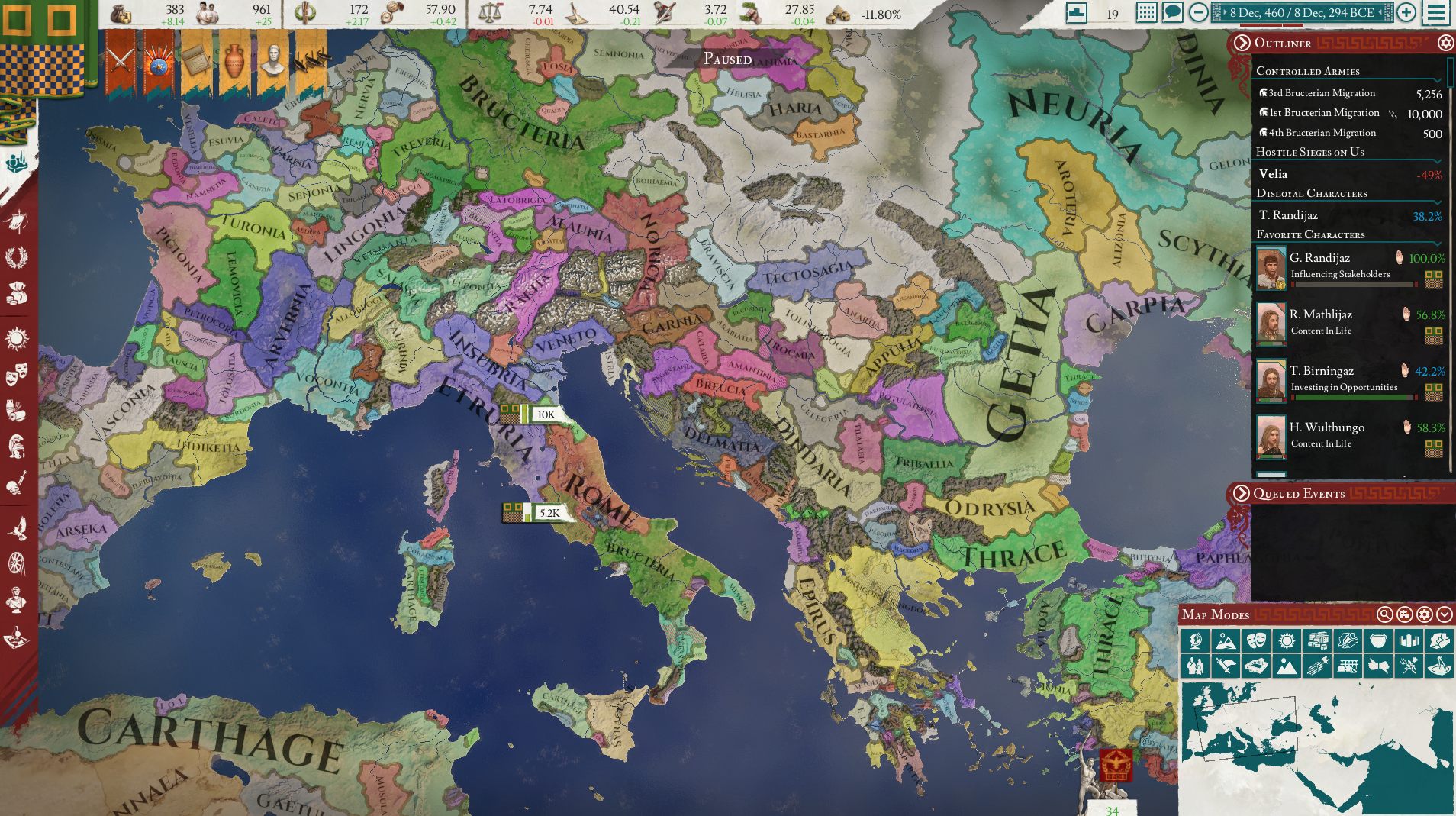
the moment I acquired Magna Graeca
2) When I passed through Armenia, I captured an admiral from looting. I immediately received Armenia's 25 ship navy. Took an admiral from Colchis soon thereafter and got 2 ships from them.
Since migratory AI units are turned off, these cases can only be created by the player. I love it in SP, but I might need to carefully mentally prepare people I'd play with in MP. Most folks don't play migratory tribes and are quite shocked being confronted with the hordes. Now also gaining characters, provinces, navies and who knows, maybe armies, are powers that many might consider...unnatural.
Great update, I'm really enjoying it! There's a little mistake in a new function for migratory armies. When looting a city, the tooltip now mentions there's a 10% chance for imprisoning a character. This chance is actually 100%.
Not only do we consistently get a character every time a city is looted, but there are other effects that have been super fun, but possibly unintended.
1) As Bructeria, a German tribe, I was in an early war with Rome, following a wardec from looting until below -100 relations. All was going as usual, until I looted a small Roman settlement, that was provincial capital, just North of the Latium province, bordering Etruria. The Roman I captured was probably governor of Magna Graeca, because instantly my tribe was given full control over all Roman Magna Graeca. It made for a very interesting game. It never happened again in my extensive looting across the world thereafter. 95% of that looting was while at peace, so I suspect a transfer of province control may only happen when at war.

the moment I acquired Magna Graeca
2) When I passed through Armenia, I captured an admiral from looting. I immediately received Armenia's 25 ship navy. Took an admiral from Colchis soon thereafter and got 2 ships from them.
Since migratory AI units are turned off, these cases can only be created by the player. I love it in SP, but I might need to carefully mentally prepare people I'd play with in MP. Most folks don't play migratory tribes and are quite shocked being confronted with the hordes. Now also gaining characters, provinces, navies and who knows, maybe armies, are powers that many might consider...unnatural.
Last edited:
- 2
Very solid work , congratulations.
I am experimenting with Parthia and I cannot seem to avoid the Dahae Event.
Event integrating the Dahae culture doesn't save the day in very hard setup.
Is there a realistic way to avoid changing tags through the event or is this your original goal?
For example through the peacefull part of the mission tree , you get the player to start wars againt dahae tribes.
But if you succeed in the war , you get more Dahae Pops so that the timer is ticking more quiclky and you cannot avoid the switching tags.
Am I missing something?
What was your original goal when designing this mechanic?
Also , when switching tag ( if i cannot avoid it) is there a way to prepare and get stronger?
I am experimenting with Parthia and I cannot seem to avoid the Dahae Event.
Event integrating the Dahae culture doesn't save the day in very hard setup.
Is there a realistic way to avoid changing tags through the event or is this your original goal?
For example through the peacefull part of the mission tree , you get the player to start wars againt dahae tribes.
But if you succeed in the war , you get more Dahae Pops so that the timer is ticking more quiclky and you cannot avoid the switching tags.
Am I missing something?
What was your original goal when designing this mechanic?
Also , when switching tag ( if i cannot avoid it) is there a way to prepare and get stronger?
Very solid work , congratulations.
I am experimenting with Parthia and I cannot seem to avoid the Dahae Event.
Event integrating the Dahae culture doesn't save the day in very hard setup.
Is there a realistic way to avoid changing tags through the event or is this your original goal?
For example through the peacefull part of the mission tree , you get the player to start wars againt dahae tribes.
But if you succeed in the war , you get more Dahae Pops so that the timer is ticking more quiclky and you cannot avoid the switching tags.
Am I missing something?
What was your original goal when designing this mechanic?
Also , when switching tag ( if i cannot avoid it) is there a way to prepare and get stronger?
Not being taken over is made to be difficult (I mean, history), but possible. Anyway, this will be rebalanced.
Keep in mind though that there are many tools to influence pop happiness (privileges, good stab, innovations, capital surplus goods, governor policy); ideally you'd in that scenario get Dahae culture 2-3 privileges, get it integrated, and only then move into the steppes.
Also on the disloyal path you have a task that allows you to fight off the invasion.
About stuff to do to get stronger in preparation for the tagswitch, there's nothing substantial I think war-wise - you'll land with good tools to win the war against Seleucids either way. You're being taken over, so someone has to show up with the army to do that ;P
However, in the meantime e.g. good thing would be to get your research efficiency and military experience up, as those things will stay with you (and frankly, are main benefits compared to start-from-tribes option)
- 1
Threadmarks
View all 98 threadmarks
Reader mode
Reader mode

